- Home
- About
- Map
- Trips
- Bringing Boat West
- Migration West
- Solo Motorcycle Ride
- Final Family XC Trip
- Colorado Rockies
- Graduates' XC Trip
- Yosemite & Nevada
- Colorado & Utah
- Best of Utah
- Southern Loop
- Pacific Northwest
- Northern Loop
- Los Angeles to NYC
- East Coast Trips
- Martha's Vineyard
- 1 Week in Quebec
- Southeast Coast
- NH Backpacking
- Martha's Vineyard
- Canadian Maritimes
- Ocracoke Island
- Edisto Island
- First Landing '02
- Hunting Island '02
- Stowe in Winter
- Hunting Island '01
- Lake Placid
- Chesapeake
- Provincetown
- Hunting Island '00
- Acadia in Winter
- Boston Suburbs
- Niagara Falls
- First Landing '99
- Cape Hatteras
- West Coast Trips
- Utah Off-Roading
- Maui
- Mojave 4WD Course
- Colorado River Rafting
- Bishop & Death Valley
- Kauai
- Yosemite Fall
- Utah Off-Road
- Lost Coast
- Yosemite Valley
- Arizona and New Mexico
- Pescadero & Capitola
- Bishop & Death Valley
- San Diego, Anza Borrego, Joshua Tree
- Carmel
- Death Valley in Fall
- Yosemite in the Fall
- Pacific Northwest
- Utah Off-Roading
- Southern CA Deserts
- Yosemite & Covid
- Lake Powell Covid
- Eastern Sierra & Covid
- Bishop & Death Valley
- Central & SE Oregon
- Mojave Road
- Eastern Sierra
- Trinity Alps
- Tuolumne Meadows
- Lake Powell Boating
- Eastern Sierra
- Yosemite Winter
- Hawaii
- 4WD Eastern Sierra
- 4WD Death Valley +
- Southern CA Deserts
- Christmas in Tahoe
- Yosemite & Pinnacles
- Totality
- Yosemite & Sierra
- Yosemite Christmas
- Yosemite, San Diego
- Yosemite & North CA
- Seattle to Sierra
- Southwest Deserts
- Yosemite & Sierra
- Pacific Northwest
- Yosemite & South CA
- Pacific Northwest
- Northern California
- Southern Alaska
- Vancouver Island
- International Trips
- Index
- Tips
- Books
- Photos/Videos
- Search
- Contact
Los Banos KOA
Tuesday, February 21, 2017 - 9:30am by Lolo421 miles and 8 hours from our last stop - 1 night stay
Travelogue
As we have learned from our previous trips to Southern California, I5 is surprisingly devoid of services north of Bakersfield. However, on our last drive north, we discovered the KOA in Los Banos, a nice campground just 3 miles off I5, about 3 1/2 miles from home.
Since all the sites are full hookups, it is a great place to start prepping the motorhome for storage - clean, vacuum, final dump, etc.
Description
KOA campground located just 3 miles west of I5, near the San Luis Reservoir State Recreation Area.
Joshua Tree National Park
Thursday, February 16, 2017 - 9:15am by Lolo100 miles and 2.5 hours from our last stop - 5 night stay
Travelogue
Day 1 – Get two campsites in Jumbo Rocks Campground and 4WD the Geology Tour Road
 Jumbo Rocks CampgroundThe weather during our visit to Anza-Borrego had been beautifully warm and sunny, but the next two days (Friday and Saturday) were forecast to be miserable – cooler temperatures, heavy rain, and wind. There was even snow forecast in Death Valley.
Jumbo Rocks CampgroundThe weather during our visit to Anza-Borrego had been beautifully warm and sunny, but the next two days (Friday and Saturday) were forecast to be miserable – cooler temperatures, heavy rain, and wind. There was even snow forecast in Death Valley.
Poor Herb. He loves the warmth of the desert and had been so looking forward to a lengthy desert tour with such stops as Joshua Tree, Mojave Preserve, and Death Valley.
Rather than just giving up and going home, I tried to figure out how best to salvage the trip. Rock climbing is better in cooler temperatures than in normal desert heat, so I texted the boys and asked them if they wanted to join us in Joshua Tree, a premier rock climbing destination, for the long Presidents’ Day weekend. I was going out a bit on a limb here, because we didn’t have a campsite in Joshua Tree, nor did we know if we could get one. However, Jumbo Rocks Campground’s first-come-first-served policy, our ability to arrive there on a Thursday, and the forecast of rain for the next two days gave me hope.
 Geology Tour RoadThe boys immediately said yes, and asked us to grab a second campsite if we could, as their girlfriends and Celeste’s parents wanted to come as well. Oh boy, I had really set something in motion that lots of people were pretty excited about. I only hoped that I could deliver. Not only was I looking for one good campsite, but now I had to find two, preferably next to each other.
Geology Tour RoadThe boys immediately said yes, and asked us to grab a second campsite if we could, as their girlfriends and Celeste’s parents wanted to come as well. Oh boy, I had really set something in motion that lots of people were pretty excited about. I only hoped that I could deliver. Not only was I looking for one good campsite, but now I had to find two, preferably next to each other.
So, we set off from Anza-Borrego early Thursday morning and drove the 3 hours to the Jumbo Rocks Campground in Joshua Tree. We were able to get two sites next to each other, but the campground was much fuller than I expected. I am sure that if we had waited another day or even a few more hours, it would have been too late.
No rain yet, so we headed out in the Subaru to take a drive on the Geology Tour Road, an 18-mile dirt road through some of the park’s most distinctive geological formations. The first 5 miles of the drive, up until Squaw Tank, doesn’t required 4WD, the 8 mile loop around Pleasant Valley after that does.
 Geology Tour RoadThe drive is pure Joshua Tree scenery – jumbles of red rock boulder, hundreds of the name-sake Joshua trees, and the intriguing open expanse of the Pleasant Valley playa. On the way back, we stopped at Squaw Tank to see the small dam built by 19th century ranchers to collect rain water for their cattle. This was also an area used by nomadic Native Americans more than 1,000 years ago. The natural tanks were a great place to collect water and the openings in the rock could have been used for shelter. Stone mortars used for grinding see can be found in the bedrock.
Geology Tour RoadThe drive is pure Joshua Tree scenery – jumbles of red rock boulder, hundreds of the name-sake Joshua trees, and the intriguing open expanse of the Pleasant Valley playa. On the way back, we stopped at Squaw Tank to see the small dam built by 19th century ranchers to collect rain water for their cattle. This was also an area used by nomadic Native Americans more than 1,000 years ago. The natural tanks were a great place to collect water and the openings in the rock could have been used for shelter. Stone mortars used for grinding see can be found in the bedrock.
Afterwards, we returned to the campground to settle in for the day. Jumbo Rocks is a beautiful destination in its own right, with huge boulders and interesting rock formations strewn throughout. It was nice to just sit in the back of the RV with a glass of wine, watching the rocks change colors in the evening light.
Day 2 – 4WD Covington Flats to Eureka Peak
 Off-roading to Eureka PeakWe had company coming and not much food left after 10 days on the road, so needed to do a massive food shopping adventure at the Vons in Yucca Valley.
Off-roading to Eureka PeakWe had company coming and not much food left after 10 days on the road, so needed to do a massive food shopping adventure at the Vons in Yucca Valley.
On the way out of the park, we stopped at the Visitor Center in Twentynine Palms to ask the ranger for an interesting 4WD road to take with a Subaru Forester. He told us that most of the off-roading in Joshua Tree is fairly hardcore and that the heavy winter rains had made conditions even more challenging, but that we should have no problem with Covington Flats to Eureka Peak in the northwestern corner of the park. Perfect. That was right near the Vons. We would do the drive first and then food shop afterwards.
The Covington Flats area was a great suggestion. The roads were good and we got to see some of the park’s largest and oldest Joshua trees. Some of them were more than 30 feet high. The weather started to change for the worse during our drive, and by the time we got to Eureka Peak, the wind was so strong that we couldn’t even get out of the car to enjoy the wonderful view. Still it was a really fun 25-mile drive.
The food shopping was a lot less fun, but it was kind of exciting to be getting ready for visitors.
Day 3 – Awaiting company and a cozy dinner for 8 in the motorhome
 Sunset on Jumbo Rocks CampgroundWe awoke to the pitter patter of raindrops on our roof, which pretty much went on all day. Still, the view out the back window was nice and we had lots of good books to read.
Sunset on Jumbo Rocks CampgroundWe awoke to the pitter patter of raindrops on our roof, which pretty much went on all day. Still, the view out the back window was nice and we had lots of good books to read.
Despite the lousy weather, the campground had totally filled up overnight. The forecast for Sunday and Monday was stellar, so I think people were willing to tough it out for one night in order to get a campsite.
Our whole gang arrived later that afternoon and since it was still raining, we all hung out in the motorhome. Amazing how much smaller it felt with eight people in it. Fortunately the mid-bath Lazy Daze has two couches in the back, between which you can set up a table. With that table and the dinette, we were able to fairly comfortably fit eight people for dinner. Let’s just say it was very cozy.
Day 4 – Rock Climbing – The Outbacks, The Blob, Bachar Boulder, and Barker Dam
 Heading to the next climbing areaJoshua Tree is one of the most popular climbing areas in the country, especially in the winter where its relatively warm weather attracts climbers from around the world. I think we pretty much had hit it at its peak weekend. However, with over 8,000 climbing routes, Joshua Tree can accommodate a lot of climbers. The problem is finding a place to stay, or even park. Already by early morning, all the campgrounds were full and the day parking areas were overflowing.
Heading to the next climbing areaJoshua Tree is one of the most popular climbing areas in the country, especially in the winter where its relatively warm weather attracts climbers from around the world. I think we pretty much had hit it at its peak weekend. However, with over 8,000 climbing routes, Joshua Tree can accommodate a lot of climbers. The problem is finding a place to stay, or even park. Already by early morning, all the campgrounds were full and the day parking areas were overflowing.
Andrew and Celeste have different climbing preferences than Tommy and Erin. Andrew and Celeste tend to prefer bouldering and challenging sport routes while Tommy and Erin like trad, multi-pitch climbs. Fortunately, we could find both in the Hidden Valley Campground area, where we were early enough to find parking – even for the motorhome, which the kids insisted on bringing to that we could have a place make lunch. We shouldn’t have listened to them.
 Tommy on Hobbit RoofHerb and I followed Andrew and Celeste through the Hidden Valley Campground to a popular bouldering area called “The Outbacks.” Meanwhile, Tommy and Erin went to the North Face of “The Blob,” a huge amorphous formation on the northwest side of the campground.
Tommy on Hobbit RoofHerb and I followed Andrew and Celeste through the Hidden Valley Campground to a popular bouldering area called “The Outbacks.” Meanwhile, Tommy and Erin went to the North Face of “The Blob,” a huge amorphous formation on the northwest side of the campground.
After watching Andrew and Celeste boulder for awhile, Herb and I went to find Tommy and Erin on the Blob. I am definitely the weak link in this climbing family, but they are always so nice about trying to set me up on a climb that I can do, which usually means something in the 5.7 to 5.9 range. Erin led a 5.7 climb called the Hoblett so that I could follow her up. I found the bottom part fairly easy, but there was a really awkward off-width to get through the overhang. Eventually, I got it, but not without a lot of squealing.
 Herb on Hobbit RoofNext, we moved to the back side of the Blob, where Tommy and Erin took turns leading a 5.10d called Hobbit Roof. It was a very cool looking climb, with an intimidating roof dissected by a large crack. “Old Man Herb” (the boys’ affectionate term for their dad when he is climbing) did it as well. I passed, still licking my wounds from the Hoblett.
Herb on Hobbit RoofNext, we moved to the back side of the Blob, where Tommy and Erin took turns leading a 5.10d called Hobbit Roof. It was a very cool looking climb, with an intimidating roof dissected by a large crack. “Old Man Herb” (the boys’ affectionate term for their dad when he is climbing) did it as well. I passed, still licking my wounds from the Hoblett.
While we were finishing up on the Blob, Andrew and Celeste stopped by to say hello on their way to the “Bachar Boulder,” where Celeste had a date with destiny on the classic JBMFP (John Bachar Memorial Face Problem), a V5 boulder problem which she had worked on repeatedly and somewhat obsessively on their last visit to Joshua Tree.
Boulder routes are referred to as boulder problems, because figuring them out and completing them is very much like solving a problem – finding just the right moves and holds and putting the sequence together. Many climbers will work on a difficult boulder problem for weeks or even years. It is often quite elegant and beautiful to watch, and a cause for celebration when achieved.
 Andrew on Bachar BoulderAlso, bouldering has its own difficulty grading system. Rather than the 5.0 – 5.14 grades used for trad and sport climbing, boulder routes are graded from V0 to V14. As far as difficulty, a V5 is about equivalent to a 5.12a/b trad/sport climb.
Andrew on Bachar BoulderAlso, bouldering has its own difficulty grading system. Rather than the 5.0 – 5.14 grades used for trad and sport climbing, boulder routes are graded from V0 to V14. As far as difficulty, a V5 is about equivalent to a 5.12a/b trad/sport climb.
Although we didn’t get over to the Bachar Boulder in time to watch them, we heard later that Andrew flashed it the first time, and Celeste got to the very last move on three separate tries before falling.
Although I thought a lot of climbing had been done for the day, the kids were still ready for more. We decided to drive over to the Barker (not to be confused with Bachar) Dam to look for Gunsmoke, an 85 foot traverse rated V3.
Unfortunately, because we took the RV that morning, we were unable to get parking at the Dam, so Herb and I went back to the campground. However, they later reported that Andrew and Tommy simultaneously on-sighted Gunsmoke, while Celeste and Erin, too mentally drained from their previous efforts that day, wisely observed while drinking a beer.
Day 5 – Rock Climbing – The Outbacks, Intersection Rock, Bachar Boulder, and Tumbling Rainbow Formation
 Erin on Hobbit RoofAnother day in Joshua Tree with the kids meant another day of rock climbing. We headed back to the Hidden Valley Campground area and once again split up – Andrew and Celeste went back to the The Outbacks to play on the False Hueco Boulder and Tommy and Erin went to do a multi-pitch climb on Intersection Rock. It’s called Intersection Rock because it is literally at the intersection of Park Boulevard and Barker Dam road, rising like an island in the pavement. It’s sort of the center of the Joshua Tree climbing world.
Erin on Hobbit RoofAnother day in Joshua Tree with the kids meant another day of rock climbing. We headed back to the Hidden Valley Campground area and once again split up – Andrew and Celeste went back to the The Outbacks to play on the False Hueco Boulder and Tommy and Erin went to do a multi-pitch climb on Intersection Rock. It’s called Intersection Rock because it is literally at the intersection of Park Boulevard and Barker Dam road, rising like an island in the pavement. It’s sort of the center of the Joshua Tree climbing world.
Herb and I bouldered with Andrew and Celeste for awhile, and I even completed a boulder problem. Although it was easy by their standards, it was still scary for me, as it required me to climb about 10 or 12 feet off the ground without ropes.
From our boulder, we were actually able to spot Tommy and Erin climbing up the rightmost diagonal crack on Intersection. They were on a 5.10b route called Right Ski Track. When looking at it, you could easily see how it got its name.
Before meeting up with Tommy and Erin, Andrew made a few attempts on Caveman, a V6+ that actually started inside what felt like a cave.
 Celeste (followed by her pony tail) coming off Bachar BoulderCeleste was still pretty obsessed with completing the Bachar Boulder problem of yesterday, so we all walked over and watched her make a few more very noble and courageous attempts. She gathered quite an enthusiastic crowd to cheer her on, but as yesterday, she fell right at the very last move. It often takes climbers months, or even years, to complete a difficult bouldering problem, so she knew she still had lots of time to get it on future trips to JT.
Celeste (followed by her pony tail) coming off Bachar BoulderCeleste was still pretty obsessed with completing the Bachar Boulder problem of yesterday, so we all walked over and watched her make a few more very noble and courageous attempts. She gathered quite an enthusiastic crowd to cheer her on, but as yesterday, she fell right at the very last move. It often takes climbers months, or even years, to complete a difficult bouldering problem, so she knew she still had lots of time to get it on future trips to JT.
The day was still young, so after consulting the climbing guidebooks, we walked along the Hidden Valley Nature Trail towards a climbing crag called Tumbling Rainbow Formation in the Real Hidden Valley Area.
When we came to the climber’s trail, Tommy and Erin went right to get to the base of Fisticuffs, a Yosemite-like 5.10b trad crack climb, while the rest of us went left towards the base of Run For Your Life, a classic 5.10b sport face route.
For me, the approach to the base of a climb is often an event in itself. This was certainly one of those instances. There was one section that was so steep, that I only made it up because three very friendly and helpful climbers took pity on me and set up a rope for me to pull my way up on. I probably reminded them of their mother.
They were so so nice and so entertaining to listen to. They were on the climb Andrew wanted to do, so we waited and watched them. The climb was rated as a 5.10b R, which means that the bolts are pretty spread out, so a fall at certain places would not be good. I was starting to get really worried. Fortunately, our new friends came to the rescue again and volunteered to take our rope up with them so that they could set up a top rope for us. I really, really liked them now.
 Sunset over Jumbo Rocks CampgroundWhile we waited, we watched Tommy and Erin on Fisticuffs around the corner to the right. After completing their climb, they came over to join us, just as our new climbing buddies were leaving.
Sunset over Jumbo Rocks CampgroundWhile we waited, we watched Tommy and Erin on Fisticuffs around the corner to the right. After completing their climb, they came over to join us, just as our new climbing buddies were leaving.
All the kids, and Herb, were able to successfully climb Run for Your Life on top rope. They then each took a go on the more difficult Runaway, a 5.11b just to the left. Although none of them got it cleanly, they did have fun trying.
I was dreading my climb back down from the base, but the boys set up a rope for me to lower myself down through the bad section. Thank God. If not, I would still be there now.
Another great day (our last in Joshua Tree) had been had by all - and another stunning sunset to enjoy.
That night Tommy and Erin drove to Palm Springs to have dinner with her grandmother, which made dinner for 6 seem almost spacious in the motorhome.
Description
 Covington Flats to Eureka PeakJoshua Tree, located 2 ½ hours east of Los Angeles and 2 ½ hours northeast of San Diego, encompasses 800,000 of pristine desert, one of the last great wilderness areas in the continental U.S. Two great desert systems meet within the boundaries of the park – the cooler, wetter, and higher Mojave Desert in the northwest and the hotter and drier Colorado Desert in the southeast.
Covington Flats to Eureka PeakJoshua Tree, located 2 ½ hours east of Los Angeles and 2 ½ hours northeast of San Diego, encompasses 800,000 of pristine desert, one of the last great wilderness areas in the continental U.S. Two great desert systems meet within the boundaries of the park – the cooler, wetter, and higher Mojave Desert in the northwest and the hotter and drier Colorado Desert in the southeast.
The park’s namesake Joshua Trees are found in the Mojave section of the park, where they thrive on the cooler temperatures and higher elevation. They were named “Joshua” trees by early Mormon pioneers, who thought their thick, stubby branches resembled the arms of the prophet raised towards the heavens.
There are three visitor centers, one at each of the three entrances to the park: Joshua Tree (West Entrance), Oasis (North Entrance) and Cottonwood (South Entrance). Since there are no services (food, fuel, cell phone, etc.) within the park, visitors should stock up at one of the gateway towns just outside the park.
There are two major paved roads through the park:
- Park Boulevard – 45-minute drive through the northern section of the park, which traverses the most scenic portions of the park, including sweeping desert views, Joshua trees, and unique boulder formations.
- Pinto Basin Road - connects Park Boulevard with the southern portion of the park, passing from the higher Mojave Desert into the lower Colorado Desert.
Stops and activities along Park Boulevard include:
- Trailhead for the Boys Scout Trail (South) and the 7.1 mile round trip hike to Wonderland of Rocks, a maze of jumbled granite boulders with hidden groves of Joshua trees http://www.protrails.com/trail/160/joshua-tree-national-park-willow-hole...
- Hidden Valley - 1-mile loop trail along the interior of a rock-enclosed valley. Rock climbing is popular in this area.
- Keys View – a short side trip (5 miles each way) to an overlook atop the Little San Bernardino Mountains (5,185 feet elevation) with panoramic views of the Coachella Valley and mountains beyond.
- Keys Ranch – a short side trip (2 miles each way) to a 150-acre ranch in a remote rocky canyon. Most of the original buildings – ranch house, schoolhouse, store, and workshop – have been restored to the way they were when William Keyes died in 1969. 90-minute walking tours of the ranch are offered daily.
- Trailhead for 3-mile round trip Ryan Mountain hike, a short but strenuous climb with one of the best panoramic views of Joshua Tree from its summit http://www.protrails.com/trail/155/joshua-tree-national-park-ryan-mountain
- Queen Valley – a side trip through a network of 13.4 miles of dirt roads through the park’s most impressive groves of Joshua trees. This is also the starting point for the Geology Tour Road.
- Geology Tour Road –18-mile dirt road through some of the park’s most distinctive geological formations. There are 16 stops along the way, so allow approximately 2 hours for the round trip. RVs are not allowed, but two-wheel vehicles may go as far as Squaw Tank, stop #9. After that point, only 4-wheel drive vehicles are advised.
- Jumbo Rocks – a wide plateau of boulders, buttes, and domes that glow with fiery hues at sunrise and sunset. The 1.7-mile Skull Rock Nature Loop passes through a maze of spectacular rock formations.
http://www.protrails.com/trail/349/joshua-tree-national-park-skull-rock-... - Junction with Pinto Basin Road – turn right for the Pinto Basin Road towards the southern portion of the park and left towards the North Entrance in the town of Twentynine Palms, where the Oasis Visitor Center is.
- Fortynine Palms Oasis - A short distance from the Oasis Visitor Center on Highway 62 is the turnoff for Canyon Road and the trailhead for the 3.3-mile (round trip) Fortynine Palms Oasis Trail. The moderately strenuous trail climbs up a ridge where barrel cacti grow and then descends a rocky canyon to a pool surrounded by fan palms. At dawn and dusk, bighorn sheep are often seen here.
http://www.protrails.com/trail/211/joshua-tree-national-park-forty-nine-...
Stops and activities along Pinto Basin Road include:
- Trailhead for .3-mile Arch Rock Trail – this short trail leads through a boulder garden to a natural bridge nestled between two large boulders
http://www.protrails.com/trail/213/joshua-tree-national-park-arch-rock-n... - Cholla Cactus Garden – a 1/4 -mile nature trail loops through a dense forest of Teddy Bear Cholla, Silver Cholla, and Creosote. The best time to visit is early morning and late afternoon when the cholla are backlit by the most dramatic lighting.
http://www.protrails.com/trail/265/joshua-tree-national-park-cholla-cact... - Cottonwood Spring – located just 7 miles from the southern entrance to the park. In addition to a Visitor Center, several hikes begin from Cottonwood Spring:
The 3-mile loop trail to Mastodon Peak, a large rock formation that early miners thought looked like the head of a prehistoric Mastodon, with excellent views of the Eagle Mountains and the Salton Sea.
http://www.protrails.com/trail/162/joshua-tree-national-park-mastodon-pe...The 7.2 miles roundtrip trail to the Lost Palms Oasis wherefan palms, large boulders and spring-fed pools line a deep and narrow canyon floor.
http://www.protrails.com/trail/161/joshua-tree-national-park-lost-palms-...
Activities in the park include:
- Hiking - There are more than 191 miles of hiking trails in Joshua Tree, ranging from ¼-mile nature trails to 35 mile multi-day trips. For a list of hikes see:
http://www.protrails.com/area/24/joshua-tree-national-park#Trails - Rock climbing - In addition to its namesake Joshua Trees, the park is also known for its granite boulders that attract rock climbers from around the world. There are more than 4,500 established routes in the park, ranging from bouldering for beginners in the Wonderland of Rocks to multiple pitch climbs at Saddle Rock and Echo Rock. The most famous climb is Hidden Valley’s Sport Challenge Rock.
- Mountain biking and 4-wheel driving - Check out this link for a listing of dirt roads in the park: http://www.gorp.com/parks-guide/travel-ta-joshua-tree-national-park-scen...
There are 9 campgrounds in the park (none of which have hookups)
- Black Rock Canyon Campground (reserveble) - located in the northwest corner of the park at the end of Joshua Lane, 5 miles south of the town of Yucca Valley. Campsites are located on a hillside at the mouth of a canyon surrounded by Joshua trees, cholla cactus, and various desert shrubs. Several hiking trails start from the campground. There are 100 sites for tents or RVs up to 35 feet.
- Indian Cove Campground (reservable) - located in the northern part of the park at the end of 3-mile long Indian Cove Road, 7 miles from the town of Twentynine Palms.The campground is very popular with rock climbers because it lies within the Wonderland of Rocks. There are 101 sites for tents or RVs up to 35 feet.
- Hidden Valley Campground (first-come-first-served) - located in the northern section of the park along Park Boulevard, about 14 miles south of the town of Joshua Tree. Two miles from the campground at Barker Dam is the trailhead for a one-mile loop through the Wonderland of Rocks and a small lake that reflects the rock formations. This campground is very popular with rock climbers. There are 45 sites for tents and RVs up to 25 feet (no hookups).
- Ryan Campground (first-come-first-served) - located on Park Boulevard a few miles south of Hidden Valley Campground. The best hike in the park – the three mile roundtrip to the summit of Ryan -- Mountain starts here. There are 31 sites for tents and RVs up to 25 feet (no hookups).
- Sheep Pass Group Camp (first-come-first-served) - located a few miles east of Ryan Campground. There are six group camps for tents or RVs up to 25 feet.
- Jumbo Rocks Campground (first-come-first-served) - located about 9 miles south of the town of Twentynine Palms on the Utah Trail. Its unique granite rock formations make it a very popular spot for rock climbers. At 4,400 feet, this campground is the highest campground in the park. There are 125 sites for tents and RVs up to 25 feet.
- Belle Campground (first-come-first-served) - located on the Pinto Basin Road about 1.5 miles south of the junction with the Utah Trail. There are 18 sites for tents and RVs up to 35 feet.
- White Tank Campground (first-come-first-served) - located on the Pinto Basin Road about 3 miles south of the junction with the Utah Trail. There are 15 sites for tents and RVs up to 25 feet.
- Cottonwood Campground (first-come-first-served) - located on the Pinto Basin Road about 7 miles north of the Southern Entrance. There are 62 sites for tents and RVs up to 35 feet.
Flying J - Thousand Palms
Thursday, February 9, 2017 - 9:15am by Lolo200 miles and 5 hours from our last stop - 1 night stay
Travelogue
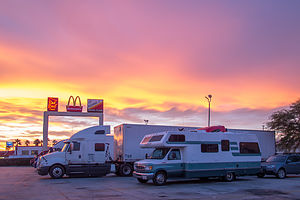 Sunrise over Flying JLA traffic is awful. It took us hours to get east towards Anza-Borrego. Rather than pay to just sleep, we found a Flying J in Thousand Palms to spend the night. It was already close to 6:00 when we got there, so must of the parking spots were already taken by 18 wheelers. Some Flying J's separate the commercial trucks from the motorhomes, but this one didn't. We managed to squeeze ourselves into the very last spot in the entire lot. The only reason it was still there was that anything bigger than us wouldn't fit.
Sunrise over Flying JLA traffic is awful. It took us hours to get east towards Anza-Borrego. Rather than pay to just sleep, we found a Flying J in Thousand Palms to spend the night. It was already close to 6:00 when we got there, so must of the parking spots were already taken by 18 wheelers. Some Flying J's separate the commercial trucks from the motorhomes, but this one didn't. We managed to squeeze ourselves into the very last spot in the entire lot. The only reason it was still there was that anything bigger than us wouldn't fit.
At least there was an In-N-Out nearby, so I didn't have to cook dinner.
Description
Flying J's are Travel Plazas that cater to truckers and RV's. Their numerous services include gas, dump station, propane, fast food restaurant, limited groceries, and even showers and a barber shop. However, the best feature of all is the section for overnight RV parking.
They are conveniently located on most of the interstates (except for the northeast).
Anza-Borrego State Park
Friday, February 10, 2017 - 9:15am by Lolo80 miles and 1.5 hours from our last stop - 6 night stay
Travelogue
Day 1 – Borrego Palms Canyon Hike
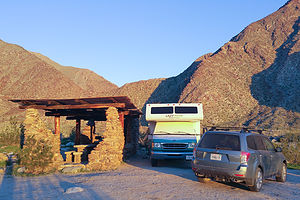 Our lovely campsiteAs I mentioned in the overview, our journey to Anza-Borrego came about as a result of a chance encounter in Yosemite with a fellow Lazy Daze owner, who not only told us how wonderful Anza Borrego was, but offered us their campground reservation at the Borrego Palms Canyon Campground, as they were unable to use it. This might not sound like much, but Anza-Borrego is extremely popular in February, and the campsite they had booked was the most highly-coveted one in the park. They weren’t kidding!
Our lovely campsiteAs I mentioned in the overview, our journey to Anza-Borrego came about as a result of a chance encounter in Yosemite with a fellow Lazy Daze owner, who not only told us how wonderful Anza Borrego was, but offered us their campground reservation at the Borrego Palms Canyon Campground, as they were unable to use it. This might not sound like much, but Anza-Borrego is extremely popular in February, and the campsite they had booked was the most highly-coveted one in the park. They weren’t kidding!
The campground had three sections: one for hookups, one for tent campers, and one for RV dry camping. Normally, I would have gone for the hookup, especially since we were going to be there 6 nights, but thankfully, I didn’t have the choice. While the hookup sites were nice enough, they were your usual asphalt parking lot with motorhomes separated by a few feet.
The dry camping area, however, was unbelievable. Our campsite, which was probably about an acre in size, was set right into the entrance to Borrego Palm Canyon, with incredible views out our back window. Rather than just an ordinary picnic table, we had a “Ramada” built by the Army Corp of Engineers in the 1930s. It was a beautiful stone and wooden structure that housed two large concrete picnic tables and a beautiful stone fireplace. We felt like the lords of the manor.
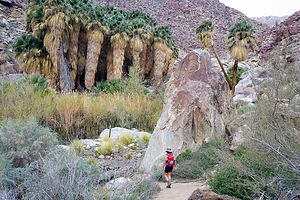 Our own little oasisAnother perk was that the trailhead for the 3.5-mile (RT) Borrego Palms Canyon hike, one of the premier hikes in the park, was in walking distance from our site.
Our own little oasisAnother perk was that the trailhead for the 3.5-mile (RT) Borrego Palms Canyon hike, one of the premier hikes in the park, was in walking distance from our site.
Since it was only 3:30, we decided to set out on the trail that afternoon. In retrospect, I think it would have been better to do the hike in the morning when the morning sun paints the canyon with light. By 3:30, the shadows were already filling in the canyon.
For about a half mile, the trail meandered along a landscaped path bordered by boulders and ocotillo cacti before coming to our first creek crossing. From this point on, the trail became a bit confusing. I am sure that we zig zagged back and forth across that creek too many times in our attempt to follow the trail, but we couldn’t get too lost, as all we had to do was head towards the tops of the palm trees that we could see in the distance.
Eventually, we came to a short stone staircase, and after crossing the stream a few more times, we entered the Borrego Palm Oasis, one of the largest and last remaining naturally occurring native California palm groves on the planet.
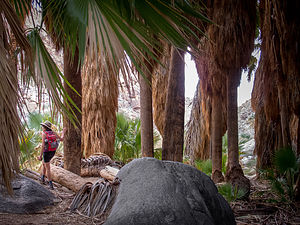 Lolo among the PalmsIt was so lush and green that it was hard to believe we were in a desert – not to mention all the stream crossings we had done and would have to repeat on the way back.
Lolo among the PalmsIt was so lush and green that it was hard to believe we were in a desert – not to mention all the stream crossings we had done and would have to repeat on the way back.
As impressive as the grove is, it has a lot fewer mature palms today as a result of severe flashfloods in 2003 and 2010, which wiped out a significant number of trees, the trunks of which are scattered throughout the canyon. I mistakenly bumped into a dead branch and was surprised to look down and find my leg bleeding. Palm trees always seem so innocuous to me, but even they have sharp thorns for defense.
The grove was making a comeback though. There were lots of cute little palm trees sprouting up throughout.
We retraced out steps back out of the canyon, crisscrossing the stream again and again. It was almost dark by the time we got back to our campsite. The sun disappears behind the canyon walls so early this time of year.
Day 2 – Hellhole Canyon Hike to Maidenhair Falls and 4WD to Fonts Point
 Hellhole Canyon palm oasisWe woke that morning, as we would every morning during our stay here, to an incredible view out our back window of the canyon, colorfully painted by morning light.
Hellhole Canyon palm oasisWe woke that morning, as we would every morning during our stay here, to an incredible view out our back window of the canyon, colorfully painted by morning light.
Our first stop that day was to the nearby Visitor Center, mostly to find out about 4WD road conditions, as that was something Herb very much wanted to do with our Subaru. We already had two excellent books: “California Desert Byways” and “The Anza-Borrego Desert Region,” which is pretty much the Bible for exploring the park, but it’s always wise to get some local knowledge as to the current road conditions.
While at the Visitor Center, we also picked up their informative “At Home in Anza-Borrego Desert Park Brochure,” which has recommendations for things to see and do in the park. I took it as my personal challenge to do as many of them as we could, which brought fear to Herb’s heart as he visualized any chance of his dream of just sitting still in the sun, reading a book and not moving, eluding him.
Herb watched warily as I checked Borrego Palms Canyon hike off on my Things to See and Do grid and plotted our next day’s adventure. He was not amused when I told him that I was going to try to get Bingo by checking off the entire grid.
First stop for the day – Hellhole Canyon, a 5-mile hike into a narrow canyon to a hidden waterfall oasis. This time we had to drive to the trailhead, which was just a mile south of the Visitor Center on Montezuma Valley Road (S22).
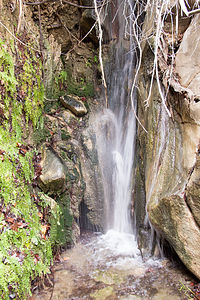 Maidenhair Falls in Hellhole CanyonThe hike began on the California Riding and Hiking Trail, where we meandered through typical desert scrubland before the Hellhole Canyon Trail split off at about 0.3 miles. We were able to identify cholla and ocotillo cacti, but there were plenty of other interesting desert plants that I wish we knew more about. We probably should have taken the short Nature Trail by the Visitor Center to learn more before setting out on our own.
Maidenhair Falls in Hellhole CanyonThe hike began on the California Riding and Hiking Trail, where we meandered through typical desert scrubland before the Hellhole Canyon Trail split off at about 0.3 miles. We were able to identify cholla and ocotillo cacti, but there were plenty of other interesting desert plants that I wish we knew more about. We probably should have taken the short Nature Trail by the Visitor Center to learn more before setting out on our own.
Soon after the split, we came upon a pile of rocks resembling a grave with a sign reading “they didn’t bring enough water,” an ominous warning to those that do not take the harshness of the desert seriously. I think that danger applies to summer hikes, but I found myself instinctively checking to make sure my water bottles were in the side pockets of my backpack.
Eventually the trail climbed out of the wash and the walls of the canyon began closing in. There really was no set trail, so we spent the next mile and a half or so crisscrossing streams, bushwacking, and rock scrambling. It was quite confusing.
We eventually came to a grouping of about two or three short palm trees, but continued on hoping that this was not the oasis we were promised – and there was definitely no waterfall here. After a bit, we came to the second oasis, lusher and thicker, huddled around a stream.
We still had no idea where the waterfall was, but fortunately we met some returning hikers that told us we were almost there. They were right. After a bit more scrambling we arrived at a third oasis and lovely Maidenhair Falls, trickling over moss-covered canyon walls into a shallow pool.
I would say that we retraced our steps back, but we really had no idea just which of the many footprints in every direction were ours. We figured we would be fine if just followed the stream downwards.
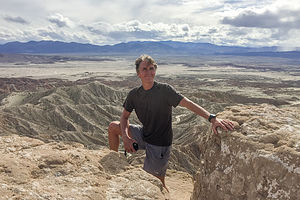 Herb on Fonts PointAll in all, the hike was 5.3 miles with about a 1,000 foot elevation gain.
Herb on Fonts PointAll in all, the hike was 5.3 miles with about a 1,000 foot elevation gain.
Herb was itching to get the Subaru off-road, so we consulted his California Desert Byways guide for a recommendation. Since we were relatively new at this, and the Subaru is not as hardcore an off-road vehicle as a Jeep, we wanted to ease into this gently. Plus, we weren’t in it for the love of rock crawling, but rather as a means to get to some beautiful, desolate areas.
Fonts Point seemed like the perfect place to start – 7.8 miles round trip over a relatively easy, but very sandy road, with a big reward at the end – spectacular view of the Borrego Badlands, the Salton Sea, and the Fish Creek Mountains in the distance.
The Subaru performed like a champ and the drive was really fun. We would definitely be doing more of this during our stay in Anza-Borrego.
Day 3 – 4WD Fish Creek Wash, Wind Caves Hike, and Galleta Meadows
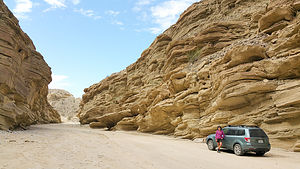 Fish Creek WashThe off-roading to Fonts Point yesterday had been so rewarding and fun that we decided to take on a longer and slightly more challenging one – the 25 mile (RT) drive up Fish Creek Wash to Sandstone Canyon. Plus, the author of our “California Desert Byways” guide said, “If you do only one drive in the park, this should be the one.” Sounded like a plan.
Fish Creek WashThe off-roading to Fonts Point yesterday had been so rewarding and fun that we decided to take on a longer and slightly more challenging one – the 25 mile (RT) drive up Fish Creek Wash to Sandstone Canyon. Plus, the author of our “California Desert Byways” guide said, “If you do only one drive in the park, this should be the one.” Sounded like a plan.
We packed lunch and headed out, this time east on Route 78 to the town of Ocotillo Wells. From there, we went south on Split Mountain Road for about 8 miles to the beginning of the Wash. At the entrance, we reset our odometer, so that we could follow the mile by mile description of the drive in Lindsay’s “Anza-Borrego Desert Region Guide,” considered the Bible by the Visitor Center.
After about a mile and a half of relatively easy driving, we entered Split Mountain Gorge, a narrow cut in the mountains where cliff walls, several hundred feet high, towered above us. The split separates the Vallecito Mountains on the right and the Fish Creek Mountains on the left.
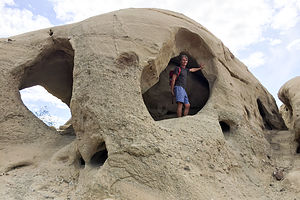 Herb in Wind CavesAt mile 3.8, we stopped to admire the fascinating anticlines on the canyon walls, where the rock layers had been bent and twisted into U-shaped bows and curves by tectonic activity millions of year ago. They were beautiful.
Herb in Wind CavesAt mile 3.8, we stopped to admire the fascinating anticlines on the canyon walls, where the rock layers had been bent and twisted into U-shaped bows and curves by tectonic activity millions of year ago. They were beautiful.
At mile 4.4, we parked at the trailhead for the Split Mountain Wind Caves. The trail was not exactly obvious. We followed a faint scar up the steep east side of the wash and eventually found the wind caves, a collection of sandstone formations with wind-eroded pockets, some of them large enough to crawl through and sit in. Even without the fascinating wind caves, the views of the Carrizo Badlands below made the 1.3-mile hike worthwhile.
Back in the Subaru, we continued along the Wash, bypassing the choice at mile 7.2 for the Loop Wash spur.
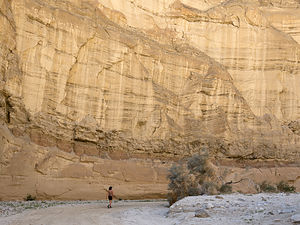 Sandstone CanyonAt mile 10.7 we came to an interesting sandstone rock formation known as the Layer Cake, because of its multi-colored bands of green and gray.
Sandstone CanyonAt mile 10.7 we came to an interesting sandstone rock formation known as the Layer Cake, because of its multi-colored bands of green and gray.
A little bit further, at mile 12.5, we reached Sandstone Canyon, a high wall, narrow slot canyon that was drivable until 1992, when thousands of tons of debris came tumbling down near its mouth. We parked at the entrance and walked for about a half mile into the canyon.
After a lunch break, we retraced our route back to Split Mountain Road.
As we were driving back to the campground along Borrego Springs Road, Herb noticed a huge metal elephant off to our right. We immediately turned off onto a dirt road and soon found ourselves driving past majestic elephants, rearing stallions doing battle, and frighteningly giant birds. We had found ‘Galleta Meadows! Or, at least a small part of it.
 Galletta Meadows - Fighting StallionsIn preparation for this trip, Herb had watched dozens of YouTube videos on things to do and places to see in and around Anza-Borrego and had come across Galleta Meadows, a collection of more than 100 gigantic metal sculptures scattered across the barren landscape around the park.
Galletta Meadows - Fighting StallionsIn preparation for this trip, Herb had watched dozens of YouTube videos on things to do and places to see in and around Anza-Borrego and had come across Galleta Meadows, a collection of more than 100 gigantic metal sculptures scattered across the barren landscape around the park.
Although we got out of the car to take pictures, you can actually just drive past the sculptures along the dirt road. We met a woman that told us that this is just a tiny sampling of the sculptures and that many more of them could be seen just north of the town of Borrego Springs.
Since it was already getting close to losing the good light of the day, we decided to save that for first thing tomorrow morning.
Day 4 – More Galleta Meadows, Alcoholic Pass Hike, and Little Surprise Canyon
 Galleta Meadows - Dueling ScorpionsWe awoke to another beautiful sunrise in Borrego Palm Canyon. Not wanting to miss the low light, we set out to find the main Galleta Meadow in search of the Sea Dragon.
Galleta Meadows - Dueling ScorpionsWe awoke to another beautiful sunrise in Borrego Palm Canyon. Not wanting to miss the low light, we set out to find the main Galleta Meadow in search of the Sea Dragon.
This time, when we got to Christmas Circle in the town of Borrego Springs, we turned north on Borrego Springs Road. It wasn’t long before bizarre metal sculptures began randomly popping out of the desert landscape. They were everywhere.
The first one we came across was a 15-foot scorpion waging battle with an equally large grasshopper. The detail was amazing.
Our personal favorite was the Sea Dragon, a 350-foot long sea serpent whose body submerges and emerges from the ground. It even crossed the road. It has the head of a dragon and the tail of a rattlesnake. You have to see it to believe it.
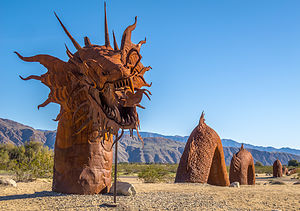 Desert SerpentNot all the sculptures were of frightening beasts, however. In fact, one of my non-scary favorites was of a prospector panhandling for gold. When I saw that his pan was filled with coins, I added a quarter of my own for good luck. Nearby him stood his horse, loaded down with a pack that was amazing in its detail.
Desert SerpentNot all the sculptures were of frightening beasts, however. In fact, one of my non-scary favorites was of a prospector panhandling for gold. When I saw that his pan was filled with coins, I added a quarter of my own for good luck. Nearby him stood his horse, loaded down with a pack that was amazing in its detail.
Another fun one was a jeep crawling up a mound of rocks, very fitting for a park with hundreds of miles of 4WD roads.
You can spend a whole day exploring these unique sculptures – there are 130 of them in all, and I have a feeling next time we visit, there will be more.
They are the work of an artist named Ricardo Breceda, who was commissioned in 2008 by Dennis Avery, the owner of the Galleta Meadows Estate, to create a collection of prehistoric creations on his three square miles of undeveloped land in Borrego Springs. Since then, the collection has grown to include human figures, like the gold miner I mentioned, along with contemporary animals, such as big horn sheep, elephants, tortoises, horses, and more.
This alone makes a visit to Borrego Springs worthwhile.
 View of Coyote Canyon from Alcoholic PassSince we were already up in the northern part of the park, we drove into Coyote Canyon and hiked the steep 2.3-mile (RT) Alcoholic Pass Trail to a lovely view of Coyote Canyon and the surrounding mountains. We wondered about the name, but the only theory we found was that the trail, which is steep and full of switchbacks, wanders this way and that, sort of like a drunk – hence the name, Alcoholic Pass.
View of Coyote Canyon from Alcoholic PassSince we were already up in the northern part of the park, we drove into Coyote Canyon and hiked the steep 2.3-mile (RT) Alcoholic Pass Trail to a lovely view of Coyote Canyon and the surrounding mountains. We wondered about the name, but the only theory we found was that the trail, which is steep and full of switchbacks, wanders this way and that, sort of like a drunk – hence the name, Alcoholic Pass.
We had time for one more short hike, so we took the ranger’s recommendation and drove down to the trailhead for Hellhole Canyon, to do the short 0.6-mile hike into Little Surprise Canyon. It was a nice, short hike, but we were a bit too early in the season, as this hike is best when the wildflowers are blooming.
That evening Herb made a campfire in our lovely Ramada stone fireplace. This campsite really was awesome.
Day 5 – Slot Canyon Hike, Side Trip to the Salton Sea, and 4WD 17 Palms
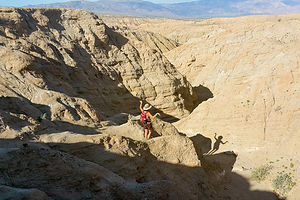 Approach to "The Slot"There are a lot of nice hikes in Anza Borrego, but the only one rated a 10 in my Moon California Hiking Guide was The Slot, a short hike down into a narrow siltstone canyon.
Approach to "The Slot"There are a lot of nice hikes in Anza Borrego, but the only one rated a 10 in my Moon California Hiking Guide was The Slot, a short hike down into a narrow siltstone canyon.
To get to the trailhead, we took the Borrego Springs Road southwest to Route 78 East. We drove about a mile and half on 78 to the unmarked, and difficult to find dirt Butte Pass Road. After about a mile, we took a left at the fork and continued for another mile to the parking area for The Slot.
 "The Slot"From the parking area, there is not an official trail marker, but there are plenty of footprints leading down into the ravine below. It’s quite steep and slippery.
"The Slot"From the parking area, there is not an official trail marker, but there are plenty of footprints leading down into the ravine below. It’s quite steep and slippery.
From the bottom we turned left into a large crevice, which was the entrance to The Slot. As we proceeded through the canyon, the walls became taller and closer together. Soon we found ourselves squeezing through sections where the walls were less than shoulder width apart.
The twisting pink and tan siltstone walls, with the blue skies above, made for some very interesting photos.
At about 0.3 miles we passed underneath a rather precarious looking rock slab lodged between the two walls, forming a bridge above us. Hopefully, today wouldn’t be the day that it became dislodged.
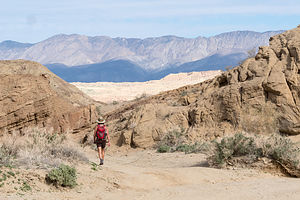 Out the other end of "The Slot"Soon afterwards, the canyon widened and we found ourselves on a jeep road, which we followed for about another mile before turning back. It was beautiful. There were colorful siltstone cliffs all around us and mountains on the horizon. There were even some wind caves in the distance. This would have been a worthwhile hike even without The Slot.
Out the other end of "The Slot"Soon afterwards, the canyon widened and we found ourselves on a jeep road, which we followed for about another mile before turning back. It was beautiful. There were colorful siltstone cliffs all around us and mountains on the horizon. There were even some wind caves in the distance. This would have been a worthwhile hike even without The Slot.
Rather than continue onto the wind caves, we decided to turn back, because we still had a full day ahead of us, as we planned to drive out to the Salton Sea, just beyond the eastern boundary of the park.
The Salton Sea has a rather interesting history:
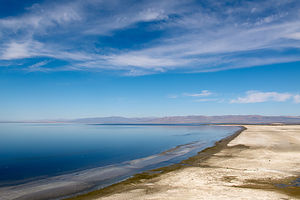 Salton SeaIt was formed in 1905 when the Colorado River breached its dikes and filled the Salton Basin. It took 18 months to get the river back on course, but the water remained. At 35 miles long and 15 miles wide, it is California’s largest lake.
Salton SeaIt was formed in 1905 when the Colorado River breached its dikes and filled the Salton Basin. It took 18 months to get the river back on course, but the water remained. At 35 miles long and 15 miles wide, it is California’s largest lake.
In the mid-1900s, developers tried to market the Sea as the California Riviera, with vacation homes along its shores. To attract tourists, the lake was stocked with fish, which in turn attracted birds, making it a birdwatchers paradise as well.
However, irrigation runoff from the surrounding agricultural lands brought high quantities of fertilizer, pesticides, and salt into the lake, polluting the lake and killing off most of its fish. Needless to say, the dream of the area becoming a California Riviera never happened, and the area is quite economically depressed today.
Two other interesting facts about the lake: the surface elevation is about 227 feet below sea level and its salinity levels are greater than that of the Pacific Ocean, but less than the Great Salt Lake.
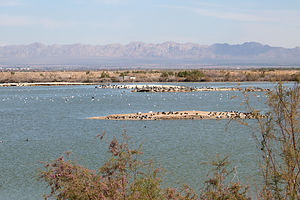 Salton Sea - Sonny Bono National Wildlife RefugeWe started our exploration of the area at the Sonny Bono National Wildlife Refuge area on the lake’s southern shore. This wildlife refuge was created in 1933 by President Hoover, before Sonny Bono was even born, but because of his efforts as a Congressman to try to save the Salton Sea, it was renamed in his honor in 1998.
Salton Sea - Sonny Bono National Wildlife RefugeWe started our exploration of the area at the Sonny Bono National Wildlife Refuge area on the lake’s southern shore. This wildlife refuge was created in 1933 by President Hoover, before Sonny Bono was even born, but because of his efforts as a Congressman to try to save the Salton Sea, it was renamed in his honor in 1998.
The Refuge is located along the Pacific Flyway, so thousands of waterfowl and other birds spend the winter here feeding, resting, and nesting. Originally the refuge consisted of approximately 37,000 acres, but because of flooding, only 2,200 manageable acres remain. Dikes have been built to try to prevent further encroachment on the refuge.
From the observation platform behind the visitors center, Herb and I took the Rock Hill Trail along a levee and out to a hill overlooking the Salton Sea. From atop the hill, there was a great view of the Salton Sea, as well as numerous birds to observe. However, since Herb and I are not exactly birders, I am sure we didn’t fully appreciate what we were seeing.
The walk is supposed to be a 2-mile loop, but the second half of the loop was closed because of nesting birds. So, we retraced our steps back to the Visitor Center.
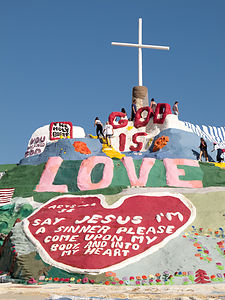 Salvation MountainUsually I am the one that does the majority of the trip planning, but this time Herb had taken charge using You Tube as his resource. It’s amazing how much information he had gathered about interesting places to see in the area. It was kind of nice to just sit back and enjoy the ride.
Salvation MountainUsually I am the one that does the majority of the trip planning, but this time Herb had taken charge using You Tube as his resource. It’s amazing how much information he had gathered about interesting places to see in the area. It was kind of nice to just sit back and enjoy the ride.
The first stop on Herb’s tour was Slab City, “the last free place in America,” located about 10 miles east of the Salton Sea. Slab City used to be a Marine training base, but after World War II, the military left, leaving concrete slabs behind – hence, “Slab City.”
Today squatters live on this state-owned land and don’t pay any rent. There are about 200 year-round residents, but in the winter they are joined by thousands of “snowbirders,” who come for the warmth and the free camping.
At the entrance to Slab City, we stopped at Salvation Mountain, something I had never heard of nor dreamt existed. You really have to see it to believe it.
The “mountain” is not a real mountain, but rather built, by a local named Leonard Knight using adobe mixed with straw, and about a half million gallons of brightly-colored paint. It stands 50-feet high and 150-feet across. It surface is entirely covered with Christian sayings, Bible verses, and calls to “Love Each Other”. I would say the style is early psychedelic.
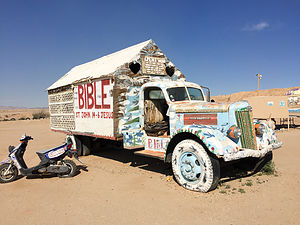 Salvation MountainThe state of California once tried to declare it a hazardous waste site and have it destroyed, but Knight and supporters of his mountain prevailed, and it now attracts thousands of tourists and folk art lovers from around the world. In 2000, the Fold Art Society of America declared it “a folk art site worthy of preservation and protection.”
Salvation MountainThe state of California once tried to declare it a hazardous waste site and have it destroyed, but Knight and supporters of his mountain prevailed, and it now attracts thousands of tourists and folk art lovers from around the world. In 2000, the Fold Art Society of America declared it “a folk art site worthy of preservation and protection.”
After Leonard Knight entered long-term care in 2011, a group of volunteers was organized to protect and maintain the site. In 2012, Salvation Mountain, Inc. was established to support them. Many visitors bring paint to donate to the project.
Our tour of the Salton Sea and Slab City wasn’t over yet. Herb still had one more You Tube discovery up his sleeve – East Jesus, an experimental art community and art garden museum that is the antithesis of Salvation Mountain in terms of theme.
When we arrived at East Jesus, we were greeted by a guy reclining in a beach chair under a patio umbrella, who asked us if we had any questions. He even volunteered to give us a tour, which we declined as we wanted to wander about on our own. Admission is free, but we placed some money in the donation box strategically placed near his side.
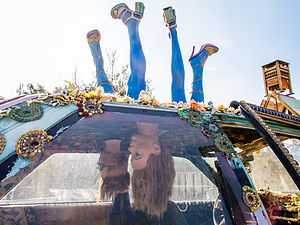 East Jesus experimental art communityI’ve never been to Burning Man, but I have a feeling this place was pretty close. I felt like I had stepped into a different realm with its own set of rules and worldview.
East Jesus experimental art communityI’ve never been to Burning Man, but I have a feeling this place was pretty close. I felt like I had stepped into a different realm with its own set of rules and worldview.
We spent the next hour of two fascinated by the thought-provoking artwork scattered about the garden. Everything was constructed of salvaged refuse and recycled materials; in other words, trash. However, one man’s trash is another man’s raw materials and boy did these artists put them to good use. Every piece had a powerful message to be absorbed and contemplated. Some of which I understood, and some of which I nodded my head knowingly and pretended that I did.
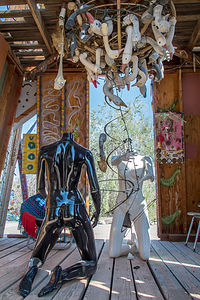 East Jesus experimental art communityIt really needs to be seen to be understood, but I will try to mention a few provoking pieces. One of my favorites was a wall of old TV sets with short messages in place of their screens, expounding the evils and corruption of mindless TV viewing and its incessant propaganda to buy more, think less, etc.
East Jesus experimental art communityIt really needs to be seen to be understood, but I will try to mention a few provoking pieces. One of my favorites was a wall of old TV sets with short messages in place of their screens, expounding the evils and corruption of mindless TV viewing and its incessant propaganda to buy more, think less, etc.
There were cars with legs sticking out of the tops and heads hanging down from the interior, an elephant made from rubber tires, a fallen house with the Wicked Witches legs sticking out from under it, a room with headless naked mannequins with goose heads hanging from the ceiling above them, etc., etc.
I can’t even begin to do justice to describing the works there. All I can say is that if your travels bring you anywhere near the Salton Sea, make sure to stop by.
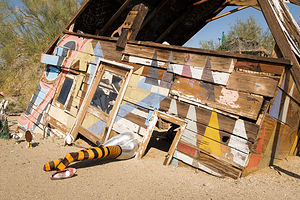 East Jesus experimental art communityI think we had pretty well covered the “Slab City” scene, so we headed back to Anza-Borrego. It had been an extremely full day already, but for some crazy reason, we decided to pack in a little more and take the 4WD road to 17 Palms Oasis, since we were passing right by the turnoff on our return into the park on S22.
East Jesus experimental art communityI think we had pretty well covered the “Slab City” scene, so we headed back to Anza-Borrego. It had been an extremely full day already, but for some crazy reason, we decided to pack in a little more and take the 4WD road to 17 Palms Oasis, since we were passing right by the turnoff on our return into the park on S22.
It was a good dirt road, so it took us less than a half hour to travel the 3.8 to the parking lot for the oasis, which was visible from where we parked. The information board at the edge of the parking lot was a sober reminder that this was not just an entertaining stop at the end of a day of sightseeing, but literally a lifesaver for inhabitants and travelers of the past.
We walked the short distance to the oasis, whose greenery stood in stark contrast to the stark and barren desert around it. I confess to counting the palms. I couldn’t help myself. It was called 17 Palms, so I wanted to make sure. There were 30 of them. Okay. I guess the oasis was doing well.
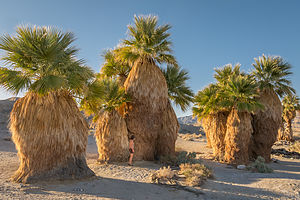 17 Palms OasisHowever, throughout the centuries the spring which feeds the oasis wasn’t always reliable, so early travelers with extra water would leave it in large glass jars in the shade of the palms for others to find. Travelers would leave notes attached to the jars.
17 Palms OasisHowever, throughout the centuries the spring which feeds the oasis wasn’t always reliable, so early travelers with extra water would leave it in large glass jars in the shade of the palms for others to find. Travelers would leave notes attached to the jars.
Today that tradition lives on, but with much less serious consequences. After a short search, I found a barrel amongst the palms, which holds a journal for current day visitors to record their own feelings and experiences at the oasis.
Besides its human history, this particular oasis is also very important to the wildlife in Anza-Borrego because it is the only year-round watering hole for many miles.
It was a lovely stop, but I think we had had more than enough exploration for the day. It was definitely time to hit the campsite.
Day 6 – Pictograph Trail Hike, and 4WD Oriflamme and Pinyon / Nolina Canyons
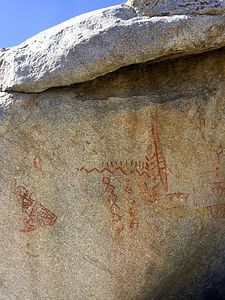 Pictographs on Pictograph TrailFor our last day in Anza-Borrego we decided to explore Blair Valley, south of California Route 78 along County Road S2.
Pictographs on Pictograph TrailFor our last day in Anza-Borrego we decided to explore Blair Valley, south of California Route 78 along County Road S2.
We turned in at the sign for the Blair Valley Campground and continued on a dirt road through a lovely valley. It was a beautiful spot to set up camp. We drove 5 ½ miles, following the signs for the Pictograph Trail.
From the trailhead, the trail lead up through some lovely desert terrain. Very shortly after the trail began to descend (about a half mile from the trailhead), we encountered a large boulder on the right side of the trail with some faded red symbols painted on its north face. Although the meanings of the pictographs is not known, we do know that it was painted by the Kumeyaay Indians, who lived in the Anzo-Borrego Desert over two thousand years ago.
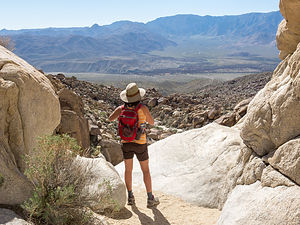 Views of Vallecito Valley from the end of the Pictograph TrailAfter he pictographs, we continued on through the wash, seeking the panoramic views our hiking book promised at the end. After about a mile, we came to an area where we were surrounded on three sides by tall rock walls. I thought at first that we had come to a dead end, but then we saw that the trail bent to the right, passing through a narrow canyon.
Views of Vallecito Valley from the end of the Pictograph TrailAfter he pictographs, we continued on through the wash, seeking the panoramic views our hiking book promised at the end. After about a mile, we came to an area where we were surrounded on three sides by tall rock walls. I thought at first that we had come to a dead end, but then we saw that the trail bent to the right, passing through a narrow canyon.
We entered the canyon and before long we were standing at the brink of a dry waterfall with a 150 foot dropoff below. From the edge we had a panoramic view of the far off mountains and the Vallecito Valley.
From there, we retraced our steps back out to the trailhead and the return drive through lovely Blair Valley.
Yesterday had been so action-packed that Herb very much wanted some downtime today to just sit in the sun and read. We thought it might be nice to drive out on another 4WD road and set up beach chairs in a scenic spot.
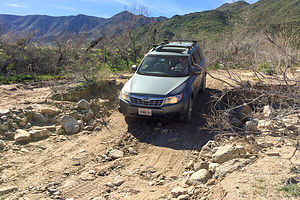 Oriflamme CanyonSince we were already down along S2, Herb chose the drive up Oriflamme Canyon, rated in our guidebook as a little more challenging than the roads we had driven on to date. I tried not to let the description freak me out -- loose rock, narrow shelf segments, possible rock fall, steep ascents and descents through switchbacks.
Oriflamme CanyonSince we were already down along S2, Herb chose the drive up Oriflamme Canyon, rated in our guidebook as a little more challenging than the roads we had driven on to date. I tried not to let the description freak me out -- loose rock, narrow shelf segments, possible rock fall, steep ascents and descents through switchbacks.
They were right, and we had to do a bit more rock crawling than we would have liked. There were several spots where I even got out of the Subaru to either move rocks out of the way or build ramps out of them. Finally, at about the 2 mile point we figured that this was not exactly the relaxing way we wanted to spend our last day, so we did an 18-point turn and returned to the joys of asphalt.
I felt really bad for Herb, because I had really been torturing him the entire time at Anza Borrego with a very aggressive schedule. I really wanted to find him a nice place in the sun to just read. As we drove back north along 78, I frantically looked through the off-road guide for a more suitable road for us to explore.
I directed Herb to make a turn onto Pinyon Wash where we drove for a few miles before bearing right on Nolina Wash. We came to a pretty spot, parked, took out our beach chairs, and spent the next 2 hours relaxing and reading. It was so very quiet and peaceful.
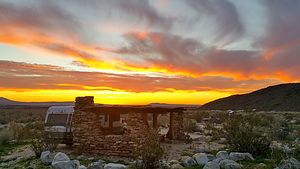 Last night at our beautiful campsiteThat pretty much wrapped up our visit to Anza-Borrego. The park is huge, but in our 6 days here we had covered a lot of ground and seen many of the recommended highlights in the park -- as Herb will attest too.
Last night at our beautiful campsiteThat pretty much wrapped up our visit to Anza-Borrego. The park is huge, but in our 6 days here we had covered a lot of ground and seen many of the recommended highlights in the park -- as Herb will attest too.
I am writing this blog about a month after our visit, and all I am seeing on the news is “Super Bloom in Anza-Borrego.” All the rain this winter has resulted in one of the most beautiful displays of wildflowers in decades. That would have been something to see.
Description
 Borrego Palms OasisWith over 600,000 acres, Anza Borrego is the largest state park in the California state park system and the largest desert state park in the U.S. Its spectacular and undeveloped Colorado Desert scenery extends from the edge of the coastal mountains east to the Salton Sea and south almost to the Mexican border. The park is located about 2 hours northeast of San Diego
Borrego Palms OasisWith over 600,000 acres, Anza Borrego is the largest state park in the California state park system and the largest desert state park in the U.S. Its spectacular and undeveloped Colorado Desert scenery extends from the edge of the coastal mountains east to the Salton Sea and south almost to the Mexican border. The park is located about 2 hours northeast of San Diego
The elevation in the park ranges from just 200 feet near the eastern edge to 6,200 feet, resulting in a variety of ecosystems and a temperature range as high as 30 degrees.
Major activities in the park include:
- Four-wheel driving on its nearly 500 miles of dirt and rocky roads (of varying difficulty)
- Mountain biking along those same four-wheel drive trails
- Hiking along its 50 miles of trails with a variety of scenery palm oases, waterfalls, slot canyons, badlands, desert gardens, etc.
- Wildlife viewing - bighorn sheep, deer, bobcats, coyotes, mountain lions, Jackrabbits, desert cottontails, 50 species of lizards and snakes, hawks, etc.
- Enjoying the spring wildflowers
- Camping – there are 12 campgrounds inside the park, but it is one of the few California parks that allows open camping throughout its 600,000 acres
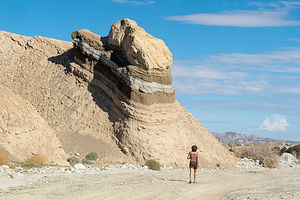 Layer Cake formation in Fish Creek WashThe small town of Borrego Springs lies at the center of the park and has ample services – lodging, restaurants, gas, grocery store, etc.
Layer Cake formation in Fish Creek WashThe small town of Borrego Springs lies at the center of the park and has ample services – lodging, restaurants, gas, grocery store, etc.
The park’s Visitor Center and the Borrego Palms Campground are just 5 miles west of the town of Borrego Springs. Be sure to pick up a copy of their ‘At Home’ magazine, which is a great source of things to do in the park.
Carpinteria Beach / Solvang
Tuesday, February 7, 2017 - 1:45pm by Lolo115 miles and 2.5 hours from our last stop - 2 night stay
Travelogue
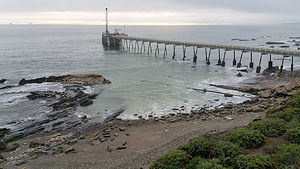 Seals on Carpinteria BeachCarpinteria State Beach, I believe, is the only place along the California coast that you can actually camp right on the beach with an RV. During our last visit, we were fortunate enough to do just that, but this time, because of the rainy weather, we chose to camp one row back, where we could still see and hear the water, but not pay $80 for the privilege.
Seals on Carpinteria BeachCarpinteria State Beach, I believe, is the only place along the California coast that you can actually camp right on the beach with an RV. During our last visit, we were fortunate enough to do just that, but this time, because of the rainy weather, we chose to camp one row back, where we could still see and hear the water, but not pay $80 for the privilege.
Since it wasn’t exactly beach weather, we decided to take a side trip to Solvang, a touristy Danish village about an hour away. This has been a place I have always wanted to visit, ever since the tales of my brother taking my Mom and Dad there every time they visited him in California. I’m not quite sure why I was so drawn to this place, as I definitely do not share my Mom’s passion for kitschy gift shops, but I was, so Herb nicely agreed to spend the day at his version of hell.
The drive was lovely, but very steep and winding – not something we would have wanted to do in the motorhome. Thank goodness for our Subaru toad.
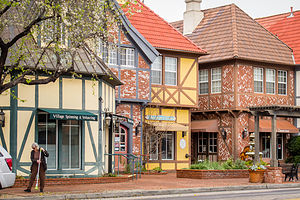 SolvangAlong the way, we stopped at the Cachuma Lake Recreation Area and were heartbroken to see that what had once been a beautiful lake set at the base of the San Rafael Mountains had been reduced by drought to a small winding river. I had forgotten that southern California was not getting the deluge of rain that we had escaped from in the north. The Marina and boat launch were hundreds of yards from the water. Still, the campground was quite active, and people were carting their kayaks and fishing boats down the make-shift ramp to what water was left.
SolvangAlong the way, we stopped at the Cachuma Lake Recreation Area and were heartbroken to see that what had once been a beautiful lake set at the base of the San Rafael Mountains had been reduced by drought to a small winding river. I had forgotten that southern California was not getting the deluge of rain that we had escaped from in the north. The Marina and boat launch were hundreds of yards from the water. Still, the campground was quite active, and people were carting their kayaks and fishing boats down the make-shift ramp to what water was left.
When we arrived in Solvang, I understood just why my Mom loved this place so much, and why Herb was such a good husband for bringing me here. I tried to test the levels of his affection for me throughout the day by randomly asking him if he would buy me a cuckoo clock, wooden clogs, or at least a beer stein.
Kidding aside, we spent a fun few hours strolling through the village enjoying its windmills, Little Mermaid Fountain, Hans Christian Andersen statue, giant red clog, and other Danish icons – as well as the two gift shops which Herb limited me to.
 Aebleskivers and other unhealthy choicesThere are also several interesting museums dedicated to Danish culture and the Danish-American experience. The first one we stopped in was the Hans Christian Andersen Museum, located above a bookstore. I had forgotten how many of the stories I had enjoyed as a child had been written by him – much more upbeat than the Brothers Grimm.
Aebleskivers and other unhealthy choicesThere are also several interesting museums dedicated to Danish culture and the Danish-American experience. The first one we stopped in was the Hans Christian Andersen Museum, located above a bookstore. I had forgotten how many of the stories I had enjoyed as a child had been written by him – much more upbeat than the Brothers Grimm.
A little bit off the beaten track was the Elverhoj Museum of History and Art, which was the former residence of one of Solvang’s most artistic families. Lovingly built, this hand-crafted structure, with its ornamental wrought ironwork, carved redwood door, and hand-painted panels is an excellent example of Scandinavian architecture. Unfortunately the Art Exhibition area was temporarily closed in preparation for an upcoming event, but the home was still interesting to explore.
The wonderful smells emanating from the numerous Danish bakeries were making us salivate, so we checked the Trip Advisor app to select a place for lunch.
I am as great believer in “when in Rome…,” so we decided to do the full touristy thing and have lunch at the Solvang Restaurant, where Miles and Jack had breakfast in the movie Sideways. I was all in, so for lunch I ordered their famous Aebleskivers and a bratwurst on the side – not exactly my usual healthy choice. It turns out that an Aebleskiver is actually a jam-filled donut. I ate four of them.
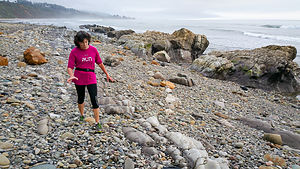 Run (kind of) along Carpinteria BeachBack at Carpinteria State Beach, I needed to run off the Aebleskivers, so Herb and I set off along the trails in the park. For awhile we ran alongside the railroad tracks, making me a bit nervous about what would happen if a train went by, as there was only about 8 feet between the tracks and the bushes. Fortunately, none did, but not wanting to risk returning the same way, Herb suggested that we continue on to see if there was a way to get down to the beach from the high bluff we were on.
Run (kind of) along Carpinteria BeachBack at Carpinteria State Beach, I needed to run off the Aebleskivers, so Herb and I set off along the trails in the park. For awhile we ran alongside the railroad tracks, making me a bit nervous about what would happen if a train went by, as there was only about 8 feet between the tracks and the bushes. Fortunately, none did, but not wanting to risk returning the same way, Herb suggested that we continue on to see if there was a way to get down to the beach from the high bluff we were on.
Finally, after 3 miles, we came to a County Park with a steep staircase down to the beach. We had a bit of a debate as to whether to go this way or back the way we had come. My fear was that it was getting near sunset and we had no idea if we could make it all the way back to the campground unobstructed. I reluctantly agreed to take the beach route.
 Herb's idea of a run along the beachWhenever I am nervous, I do things faster to get them over with, so I took off ahead of Herb so that if we did come to a roadblock, we would still have time to retrace our steps before dark. I have to admit that running at a quicker pace than usual along that beautiful hard-sand beach was a highlight.
Herb's idea of a run along the beachWhenever I am nervous, I do things faster to get them over with, so I took off ahead of Herb so that if we did come to a roadblock, we would still have time to retrace our steps before dark. I have to admit that running at a quicker pace than usual along that beautiful hard-sand beach was a highlight.
The beach was pretty deserted, but eventually I found someone to ask whether or not we could get back to the campground this way. She told me that the beach eventually was closed due to harbor seal nesting, but right before that there was a path leading to the top of the bluff. Now I could relax.
Soon, however, my beautiful hard sand running surface turned into rocky debris, forcing us to walk the remaining mile. That was okay though - the sun was setting and it was quite beautiful. Plus, we got to see a natural tar pit – there are several on the park’s beaches and bluffs.
Description
Carpinteria State Beach
Just 12 miles south of Santa Barbara, Carpinteria State Beach offers a mile of beach for beach-side camping, swimming, fishing, and tidepool exploration. It is an extremely popular destination, so camping reservations should be made well in advance.
Harbor seals and sea lions can be seen December through May, along with an occasional gray whale passing through. Tidepools contain sea anemones, starfish, crabs, snails, sea urchins, and octopus. The Channel Islands and oil rigs can also be seen along the horizon.
The campground has over 200 sites with full or partial hookups, many of which are situated right on the edge of the beach. The campground is in walking distance to the lovely little town of Carpinteria.
Solvang
 Hans Christian Andersen's Little MermaidSolvang is a Danish Village located in the Santa Ynez Valley, about 45 minutes northwest of Santa Barbara. Solvang was founded in 1911 by a group of Danes who traveled west to flee the harsh Midwestern winters. As is evidenced by the architecture and numerous bakeries, cuckoo clock, and wooden shoe stores, the village holds very tight to its Danish Heritage.
Hans Christian Andersen's Little MermaidSolvang is a Danish Village located in the Santa Ynez Valley, about 45 minutes northwest of Santa Barbara. Solvang was founded in 1911 by a group of Danes who traveled west to flee the harsh Midwestern winters. As is evidenced by the architecture and numerous bakeries, cuckoo clock, and wooden shoe stores, the village holds very tight to its Danish Heritage.
Today, over one million visitors a year come to Solvang to enjoy its Danish windmills, kitschy shops, restaurants, pastry shops, wine tasting rooms, and museums.
Morro Bay State Park and San Luis Obispo
Monday, February 6, 2017 - 1:15pm by Lolo327 miles and 6.5 hours from our last stop - 1 night stay
Travelogue
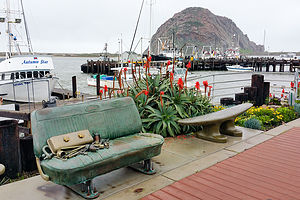 Street Art in Morro BayThis might sound totally unrelated to a travel website, but I have been trying to find indoor wicker chairs for our sunroom, but can only find them online. Herb absolutely refuses to buy an expensive chair that he hasn’t sat in and approved for comfort, so our sunroom has stood empty for almost a year.
Street Art in Morro BayThis might sound totally unrelated to a travel website, but I have been trying to find indoor wicker chairs for our sunroom, but can only find them online. Herb absolutely refuses to buy an expensive chair that he hasn’t sat in and approved for comfort, so our sunroom has stood empty for almost a year.
Finally, I got my hands on a Ratana indoor wicker furniture catalog and called the manufacturer to ask where I could sit in one. After providing my zip code, I was told San Luis Obispo, about 5 hours south of us along US 101.
“How about taking the coast route to Anza-Borrego?” I asked Herb. “I5 is so boring.”
So, we made our first day’s destination Morro Bay State Park, a park we had visited in the past. Between the beautiful harbor and estuary, quaint waterfront, and iconic Morro Rock, there is so much here to make for an enjoyable visit. Kayaking to Morro Rock has been something on our list for quite some time. Unfortunately, however, like our last visit, the weather was thwarting us again. Undaunted, we would try to make the most of it.
The weather was pretty dreary when we arrived, but since it wasn’t raining, we decided to take a walk on the Marina Boardwalk just across the way. This trail, which is quite new (built in 2012), leads from the south side of the marina parking along the estuary for about a mile. It was quite lovely.
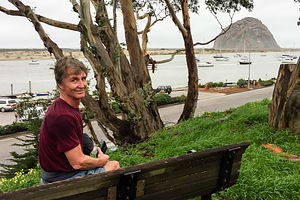 Herb and Morro RockThe next morning was cloudy, but still no rain to speak of, so we donned our sneakers and set off for a run, once again along the Marina Boardwalk trail, and then along the harbor towards Morro Rock, a huge volcanic plug rising 576 feet above the Bay at the entrance to the harbor.
Herb and Morro RockThe next morning was cloudy, but still no rain to speak of, so we donned our sneakers and set off for a run, once again along the Marina Boardwalk trail, and then along the harbor towards Morro Rock, a huge volcanic plug rising 576 feet above the Bay at the entrance to the harbor.
That damn rock is so big that it fooled us into thinking we were close. After 3 miles, the sky began to darken, and we were still a good distance from the rock. We decided to just go a little further to a marina before turning back. I am so glad we did, because we came upon a romp (I looked that one up) of otters playfully floating on their backs, resting their cute little heads on each other’s bellies, and I swear, smiling at us. What a life!
I’m still disappointed that we didn’t make it to the rock though, especially after reading that you can climb 400 steps to the top of it. Maybe next time.
On our way south, we stopped at the furniture store in San Luis Obispo that carried the indoor wicker chairs we were interested in, and found them to be just what we were looking for. To celebrate we went to lunch at the Firestone Grill, known for their tri-tip sandwiches and great beer.
Rainy days can be fun after all.
Description
Morro Bay State Park
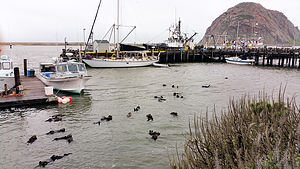 A Romp of Otters in Morro BayMorro Bay State Park is located on Morro Bay, 15 miles northwest of San Luis Obispo along scenic Highway 1. There is a 95-site campground in the park, 27 of which have partial hookups.
A Romp of Otters in Morro BayMorro Bay State Park is located on Morro Bay, 15 miles northwest of San Luis Obispo along scenic Highway 1. There is a 95-site campground in the park, 27 of which have partial hookups.
The most prominent feature in the area is Morro Rock, a 576 foot high volcanic plug that stands at the entrance to the harbor. This is one of nine “morros” or volcanic peaks that form a chain between Morro Bay and San Luis Obispo. There is a short causeway connecting the rock with the shore, but climbing on the rock itself is prohibited, because it is a reserved for the endangered peregrine falcon.
The calm waters of the bay are perfect for fishing, kayaking, and birdwatching. There are more than 15 miles of protected waters in the beautiful Morro Bay Estuary / Bird Sanctuary, which is home to California sea lions, harbor seals, sea otters, brown pelicans, and peregrine falcons.
The most popular hike in the park is to the 640-foot summit of Black Hill, one of the nine morros, from which there are spectacular views of Morro Bay and the nearby hills of Montana de Oro.
San Luis Obispo
San Luis Obispo is located at the junction of Highway 1 and US 101. Sometimes referred to as a “little Santa Barbara,” It is tucked into the mountains about halfway between Los Angeles and San Francisco.
Like many other towns and cities in California, San Luis Obispo was first established as a Spanish mission by Spanish Franciscan friars in 1772. Today the Mission San Luis Obispo de Tolosa is still an active church. The former friars’ quarters is now a small museum with artifacts from the Chumash Indians and the early Spanish settlers.
Today, the town’s main appeal is its charming, pedestrian-friendly downtown, with fine shops, galleries, and restaurants. Mission Plaza, with its brick paths and park benches along a creek, serves as the town square, often hosting festivals and concerts. During the school year the town bustles with students from California Polytechnic State University, more popularly known as Cal Poly.
South Lake Tahoe
Sunday, December 25, 2016 - 11:15am by Lolo205 miles and 4 hours from our last stop - 2 night stay
Travelogue
 Alpenglow over Lake TahoeAlthough we were pretty much packed beforehand, the final loading of the car in the morning was once again a spectacle of excess – two snowboards, two pairs of downhill skis, three pairs of cross country skis, plus food, clothing, etc.
Alpenglow over Lake TahoeAlthough we were pretty much packed beforehand, the final loading of the car in the morning was once again a spectacle of excess – two snowboards, two pairs of downhill skis, three pairs of cross country skis, plus food, clothing, etc.
Since Herb’s Forester has the most storage capacity, we switched the Thule car-top box from Tommy’s car onto Herb’s, loaded it up, and hit the road. Even with that, Tommy and I were squooshed together on half of the backseat, shackled together by one seatbelt. Let’s just say that it was very cozy.
After decades of shoveling snow in New Jersey, I definitely like the Northern California concept of “driving to the snow.” As soon as we hit the tiny town of Kyburz (population 167) on Route 50, we were in a virtual winter wonderland. Cars were parked alongside the road for miles, with families pulled over to play in the snow. What a wonderful Christmas scene! Our already high spirits were soaring.
 Our cozy little cabin in Camp RichardsonI didn’t know what to expect in terms of our cabin at Camp Richardson, but when we checked in we were totally blown away. Everything about it exceeded expectations – the two bedrooms were roomy, the kitchen was well stocked, the gas stove was already lit to greet us, and our picture window looked out over Lake Tahoe. “I’ve done it,” I gloated, as I saw the pleased looks on the faces of my adoring family.
Our cozy little cabin in Camp RichardsonI didn’t know what to expect in terms of our cabin at Camp Richardson, but when we checked in we were totally blown away. Everything about it exceeded expectations – the two bedrooms were roomy, the kitchen was well stocked, the gas stove was already lit to greet us, and our picture window looked out over Lake Tahoe. “I’ve done it,” I gloated, as I saw the pleased looks on the faces of my adoring family.
After unpacking, we took a walk along the snow-covered beach, admiring and photographing the colorful alpenglow over the lake and surrounding mountains. We also watched in awe as one brave (or perhaps crazy) young man, obviously put up to it by his friends, stripped down to swimming trunks and jumped in.
Back at our cozy little cabin, we cooked dinner and played Trivial Pursuits, before heading out once again for a walk – this time towards the nearby Tallac Historic Site, where there are three “Old Tahoe” style estates from the early 1900s, back when Tahoe was a summer retreat for the socially prominent families of San Francisco.
 Beach walkWhen we come to Camp Richardson in the summer, we love running on the paths that weave in and out of the estates, and even have returned in the evenings to sit in the rocking chairs on the porch of one, pretending that we were members of the "vieux riche."
Beach walkWhen we come to Camp Richardson in the summer, we love running on the paths that weave in and out of the estates, and even have returned in the evenings to sit in the rocking chairs on the porch of one, pretending that we were members of the "vieux riche."
Although we had headlamps, it was too dark to really get an appreciation for the homes, so we decided to walk back along the snowy beach and return to the Site another time when it was still light out.
As we were walking along the beach, we came across a large snowy ball, which looked like the bottom of a snowman. However, upon closer inspection, we realized that it was actually a snow-covered mooring ball.
It was while staring at this “ball” that the idea of a Gaidus “Feats of Strength” competition was born – inspired by the Seinfeld Festivus episode. However, rather than try to pin each other to the ground as the Costanzas did, we decided that our feat of strength would be lifting the large snow-covered mooring ball over our heads and throwing it as far as we could.
Herb immediately began whining that he didn’t want to throw his back out and ruin his chances of skiing the next day. However, he was taunted into participating by his sons.
 Feats of StrengthI reluctantly went first, but the damn thing was so heavy that I couldn’t even lift it over my head, and sort of just rolled it before removing myself from the competition and declaring myself the line judge for their throws.
Feats of StrengthI reluctantly went first, but the damn thing was so heavy that I couldn’t even lift it over my head, and sort of just rolled it before removing myself from the competition and declaring myself the line judge for their throws.
I have probably never laughed so hard as I watched each of my loved ones take a turn at hoisting a ridiculous beach-ball sized object that weighed about 30 extremely awkward pounds over their heads, stepping up to a line drawn in the snow, and hurling it as far as they could. The “feat” was generally accompanied by a loud grunting sound, especially in Herb’s case.
I think that Tommy won by about three inches, but in reality we were all winners in that no one threw their backs out and the only pain we felt was from laughing so hard. Plus, a new Gaidus Christmas tradition had been born.
Cross Country Skiing and more Reindeer Games
 Trail to Fallen Leaf LakeThe next morning when I stumbled out of our bedroom, I found Herb ever so cozily sipping coffee in a chair by the stove, peacefully gazing out over the lake. It was so idyllic that I had to stop myself from further gloating as to delivering the family the perfect holiday experience.
Trail to Fallen Leaf LakeThe next morning when I stumbled out of our bedroom, I found Herb ever so cozily sipping coffee in a chair by the stove, peacefully gazing out over the lake. It was so idyllic that I had to stop myself from further gloating as to delivering the family the perfect holiday experience.
It was difficult though, because everything was breaking my way this trip. First there was the fortuitous timing of my call to Camp Richardson to book a cabin an hour after someone had canceled the last available one.
Then there was the timing of the snowstorm on Christmas Eve - delivering a white Christmas and providing enough snow to cross country ski, while giving the road crews enough time to clear the roads before our arrival on Christmas day.
So, thanks to the storm, today we would cross country ski, right from our cabin through the forest to Fallen Leaf Lake, a few miles south of Lake Tahoe, and then back along the trails that wound through the Tallac Historic Site.
Herb, Tommy, and I had brought our own cross country skis, but Andrew needed to rent them. Fortunately, Camp Richardson has its own Mountain Sports Center, right on the premises next to the RV campground, so it was very convenient to just walk over and pick up a pair. At $19 for a full day, the price was very reasonable as well.
 Family by Fallen Leaf LakeThe staff was extremely helpful suggesting places to ski. They pointed us to a trail that started right behind their building that would bring us over to Fallen Leaf Lake.
Family by Fallen Leaf LakeThe staff was extremely helpful suggesting places to ski. They pointed us to a trail that started right behind their building that would bring us over to Fallen Leaf Lake.
About 8 inches of snow had fallen – not enough for them to machine groom the trails, but still plenty to ski on. The conditions were excellent, and since we were far from being the first skiers on them, no trail breaking was necessary.
After about 2 1/2 miles through the woods, we came to our first view of pristine Fallen Leaf Lake with snow-covered Mount Tallac across the way. We took off our skis and scampered down to lake level to better enjoy the view.
From there we skied to a beach on the northern end of the lake where there was a bench and a large rock about 100 feet from the shoreline, just begging to have snowballs thrown at it. Of course, we spent the next ½ hour taking turns trying to hit the rock with snowballs. What is it with this family and “Feats of Strength?”
From there, we skied back through the woods and across Route 89 to our cozy little cabin on the lake to have lunch.
 Herb XC skiing on Baldwin BeachAfter lunch we went out on the skis again, this time through the Tallac Historic Site, which we had been unable to appreciate in the dark the night before, and out to Baldwin Beach for more terrific views of Lake Tahoe and the surrounding mountains.
Herb XC skiing on Baldwin BeachAfter lunch we went out on the skis again, this time through the Tallac Historic Site, which we had been unable to appreciate in the dark the night before, and out to Baldwin Beach for more terrific views of Lake Tahoe and the surrounding mountains.
It was getting near 3:00 and the Mountain Outdoor Center closed at 4:00, so we skied back along the beach so that Andrew could return his skis in time. Not quite done yet, after the drop-off, we continued east along the southern shore of the lake to Pope Beach, three of us on skis and Andrew jogging with a pair of yaktrax attached to his sneakers.
All in all, we skied about 11 miles that day – not a bad day’s work.
Alpine Skiing at Heavenly Mountain Resort
 Heavenly GondolaHerb and I originally had no intention of downhill skiing during a busy holiday week, but Tommy convinced us that unlike east coast ski resorts, where you can wait as long as 30 minutes on a lift line, west coast ski resorts are much larger and can move people a lot more quickly.
Heavenly GondolaHerb and I originally had no intention of downhill skiing during a busy holiday week, but Tommy convinced us that unlike east coast ski resorts, where you can wait as long as 30 minutes on a lift line, west coast ski resorts are much larger and can move people a lot more quickly.
There are several ski resorts in the South Lake Tahoe area to choose from – Heavenly, Sierra, Kirkwood, to name a few – but Tommy was pretty sure that I would like Heavenly best, because besides the fantastic views, it was a gentler mountain meant more for intermediate skiers.
Okay, we were convinced, so rather than pay the same-day $145 lift ticket price, we bought our discounted ones online the night before for $131 – still a bit pricey as far as I’m concerned. But as the boys said, “This is probably the last time we will ski together as a family.” I’m not sure where I was going? Did they know something I didn’t?
Since we had to drive back to San Francisco today, we got up bright and early so that we could get a lot of skiing in early and hit the road before it got too late. Fortunately Tommy had been to Heavenly many times and, as a result, knew the logistics – park behind Harrah’s Casino and walk with your ski boots right onto the gondola in Heavenly Village.
 Heavenly Mountain ResortWe were one of the first ones on the gondola, which scooted us up almost 3,000 feet over 2.4 spectacular miles to Tamarack Lodge, where we could catch another lift to the top of the mountain. The gondola ride was an event in itself, and many people do just that to get to the observation deck, which has wonderful views of Lake Tahoe and the surrounding mountains.
Heavenly Mountain ResortWe were one of the first ones on the gondola, which scooted us up almost 3,000 feet over 2.4 spectacular miles to Tamarack Lodge, where we could catch another lift to the top of the mountain. The gondola ride was an event in itself, and many people do just that to get to the observation deck, which has wonderful views of Lake Tahoe and the surrounding mountains.
I recorded our skiing that day on Strava, so I know that over a 5-hour period we did 15 runs for a distance of 37.8 miles (counting up and down) and a total elevation gain of 18,534 feet.
With the exception of skiing at Badger Pass in Yosemite last Christmas, which is really a pretty small mountain even by east coast standards, this was Herb’s and my first real west coast skiing experience. I would have to say that it was pretty incredible.
Description
 Winter SailingI am not even going to attempt to give a full description of what Lake Tahoe has to offer, as we only spent a short time on its southern shore.
Winter SailingI am not even going to attempt to give a full description of what Lake Tahoe has to offer, as we only spent a short time on its southern shore.
However, briefly, Lake Tahoe is one of the highest elevation lakes (6,255 feet high) in the U.S., as well as the second deepest (1,645 feet deep) – Crater Lake is the deepest. It is located along the border between California and Nevada. The four shores of the lake are each quite different. The north is quiet and upscale, the west and east are more rugged and less developed, and the south shore is busy and tacky with neon-lit hotels and casinos. The 72-mile drive around the lake is very scenic.
Lake Tahoe is known for its clear blue and green waters and the panorama of mountains that surround it on all sides. It is a year-round destination with swimming, boating, kayaking, and various other kinds of water sports during the summer; hiking, backpacking, and camping all year round; and tremendous skiing and snowboarding in the winter.
Two interesting nearby sites we did enjoy, include:
Tallac Historic Site
The Tallac Historic Site is comprised of three private estates dating back to the early 1900s, which served as summer retreats for three very socially prominent families from the San Francisco Bay area. In an effort to preserve “Old Tahoe,” the U.S. Forest Service acquired 74 acres, which included the three estates and a quarter mile of lakefront between Emerald Bay and Camp Richardson.
Today the remains of the restored estates attract thousands of visitors interested in recapturing this bygone and significant era in Tahoe’s history. Although the architecture of each is unique from its neighbors, each captures some aspect of the “Old Tahoe” style.
A list of activities and tours is available at the Visitor Center and the Baldwin museum.
Fallen Leaf Lake
 Fallen Leaf LakeIf the thought of kayaking in a lake as large as Tahoe is a bit intimidating, as it was for me, there is a wonderful alternative just a mile south of Camp Richardson. Fallen Leaf Lake, which was created by glaciers, is approximately 3 miles long and 1 mile wide. If the glacier had continued, Fallen Leaf Lake would have been just another bay in Lake Tahoe.
Fallen Leaf LakeIf the thought of kayaking in a lake as large as Tahoe is a bit intimidating, as it was for me, there is a wonderful alternative just a mile south of Camp Richardson. Fallen Leaf Lake, which was created by glaciers, is approximately 3 miles long and 1 mile wide. If the glacier had continued, Fallen Leaf Lake would have been just another bay in Lake Tahoe.
The land surrounding the lake is privately owned, leased from the U.S. Forest Service, and part of the Lake Tahoe Basin Management Unit. Except for a marina and store at the southern end of the lake, there is very little commercial development. As a result, the water quality is extremely good.
Home Sweet Home
Saturday, October 1, 2016 - 1:30pm by Lolo460 miles and 8 hours from our last stop - 1 night stay
Travelogue
 Home Sweet Home8 hours to go. I can’t believe our odyssey was almost over.
Home Sweet Home8 hours to go. I can’t believe our odyssey was almost over.
I also couldn’t believe that now that we were no longer the length of a semi-trailer, we didn’t have to stop at truck stops for lunch anymore.
So, instead of our daily fare of Subway heroes, we stopped at In-N-Out Burger in Livermore – we were going to have to wean ourselves gradually off fast food to avoid an adverse reaction.
Finally, the Suburban and our new home met for the first time.
Description
The final drive north on I5 to our home in Sonoma County
Boulder City, Nevada to Barstow
Friday, September 30, 2016 - 1:30pm by Lolo133 miles and 2 hours from our last stop - 1 night stay
Travelogue
 Last motel breakfastAs we traveled southwest along I15, I had this aching feeling that we had forgotten something. I just couldn’t look in the rear view mirror without being surprised each time that the boat was no longer behind us. We missed it already, although I didn’t miss having to go to Truck Stops for lunch.
Last motel breakfastAs we traveled southwest along I15, I had this aching feeling that we had forgotten something. I just couldn’t look in the rear view mirror without being surprised each time that the boat was no longer behind us. We missed it already, although I didn’t miss having to go to Truck Stops for lunch.
Tired from all the work prepping and storing the boat, we only drove a few hours, stopping at a Super 8 in Barstow, California.
We used the Yelp App to look for restaurants and chose the #3 choice in Barstow - Jenny’s Grill and Mariscos, even though we had no idea what a marisco was. Luckily we didn’t know, because I later learned it means “shellfish,” and Herb is highly allergic.
This was it – our last dinner on the road. I did kind of like not having to cook, but it sure would be good to get back home.
Description
Drive southwest along I15 from Boulder City, Nevada, into California with a stop for the night in Barstow
Lake Mead National Recreation Area
Monday, September 26, 2016 - 6:30pm by Lolo325 miles and 4 hours from our last stop - 4 night stay
Travelogue
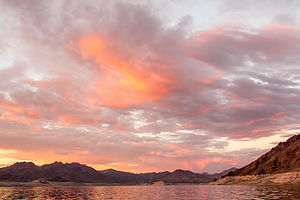 Sunset over Lake MeadThe last day of dragging the boat around the country was upon us, for today we would reach Lake Mead, the boat’s intended home -- at least for awhile.
Sunset over Lake MeadThe last day of dragging the boat around the country was upon us, for today we would reach Lake Mead, the boat’s intended home -- at least for awhile.
We had decided before embarking on this trip that rather than bringing the boat all the way back to California, we would let it live for awhile in the desert. Although we had first thought of storing it at one of our favorite places on Earth, Lake Powell in Utah, we settled instead on the more easily accessible, and still very stunningly beautiful, Lake Mead, just 30 miles outside of Las Vegas.
Before leaving home, we had reserved a storage site at the nearby Boulder City Boat Storage facility. However, before tucking it away, we thought it (and we) deserved a few days playing and camping on this beautiful lake.
Day 1 – Lake Mead Marina and short sunset cruise across Boulder Basin
 Happy Herb finally on Lake MeadOur original intention for our first night by Lake Mead was to stay at a motel, so that I could watch the second Presidential Debate – I am a bit of a political junkie. However, as we got our first view of this gorgeous lake from the Visitor Center, we figured it was stupid to pay a lot of money just to watch something that we could read about the next morning. It would be much more fun to sleep out under the stars and forget that the presidential election was even going on.
Happy Herb finally on Lake MeadOur original intention for our first night by Lake Mead was to stay at a motel, so that I could watch the second Presidential Debate – I am a bit of a political junkie. However, as we got our first view of this gorgeous lake from the Visitor Center, we figured it was stupid to pay a lot of money just to watch something that we could read about the next morning. It would be much more fun to sleep out under the stars and forget that the presidential election was even going on.
So, we continued down the hill from the National Recreation Area Visitor Center to the Lake Mead Marina, situated on the southern shore of Boulder Basin, on the southwestern end of the lake, about 2 miles (as the crow flies) from the Hoover Dam and only about 4 miles by boat.
We got a transient slip for the night. It was only $20 – what a deal! For now, we only booked one night, because we weren’t sure yet whether we wanted to spend the next few nights at a marina dock or anchored in a remote cove. There were plusses and minuses to both, but we would put that decision off until later.
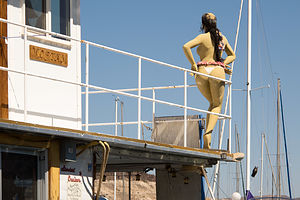 Young lady ready to party at Lake Mead MarinaWe launched the boat at a rather dubious launch area – not knowing at the time that the real launch ramp was located about a mile west by the Las Vegas Bay Marina. However, things went smoothly, and we were soon established in our new home for the night at the end of the transient dock.
Young lady ready to party at Lake Mead MarinaWe launched the boat at a rather dubious launch area – not knowing at the time that the real launch ramp was located about a mile west by the Las Vegas Bay Marina. However, things went smoothly, and we were soon established in our new home for the night at the end of the transient dock.
You could tell we were near Las Vegas, just by the general party feel there was to the marina. It was quiet now, being a Monday night in late September, but I could just imagine what this place was like on a summer weekend. Most of the boats in the marina were houseboats – perfect for large groups of people celebrating the end of a work week. One right nearby left one of their revelers behind – a scantily clad, mannequin atop the upper deck gazing out over the lake, probably wondering where her party friends had gone.
We didn’t stay settled at the dock for long. The evening light was getting so good that we decided to take the boat out for a short spin across Boulder Basin to get an unobstructed view of the sun setting on the colorful sandstone cliffs surrounding the lake. It was absolutely stunning.
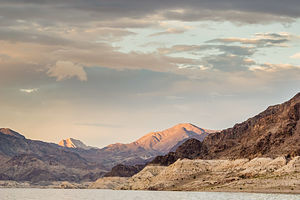 The hills surrounding Boulder BasinWhen we got back to the dock at around 7:00 that evening, I walked over to the Boat House Restaurant at the end of the dock to check out the menu for later. It seemed pretty quiet, but the door was open, so I entered only to find empty tables and two people sitting at the bar, one of which was screaming at the TV set, which happened to have the presidential debate on. She stopped dead in her tracks, collected herself, and in her best restaurant hostess voice informed me that the kitchen had just closed.
The hills surrounding Boulder BasinWhen we got back to the dock at around 7:00 that evening, I walked over to the Boat House Restaurant at the end of the dock to check out the menu for later. It seemed pretty quiet, but the door was open, so I entered only to find empty tables and two people sitting at the bar, one of which was screaming at the TV set, which happened to have the presidential debate on. She stopped dead in her tracks, collected herself, and in her best restaurant hostess voice informed me that the kitchen had just closed.
So, it was Mountain House freeze-dried beef stroganoff on the camping stove for our first meal on Lake Mead.
I could deal with this.
Day 2 – Indian Canyon Cove
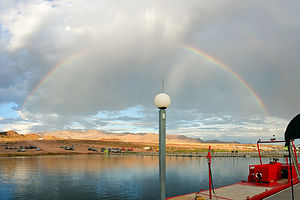 Rainbow (with no rain) by marinaSleeping in the Grady’s cozy littler cuddy cabin hadn’t been so bad – perhaps the gentle rocking and the sleep aid helped. It was quite nice to open the cuddy door and be greeted by the sun rising over the colorful cliffs. Since our boat is not exactly a yacht, it was nice to be able to just walk down the dock for the amenities we normally take for granted, like a restroom and shower.
Rainbow (with no rain) by marinaSleeping in the Grady’s cozy littler cuddy cabin hadn’t been so bad – perhaps the gentle rocking and the sleep aid helped. It was quite nice to open the cuddy door and be greeted by the sun rising over the colorful cliffs. Since our boat is not exactly a yacht, it was nice to be able to just walk down the dock for the amenities we normally take for granted, like a restroom and shower.
Before heading off for breakfast at the marina restaurant, Herb and I had a mature discussion as to whether we should stay in the marina tonight or anchor in a cove. I know how much Herb loves remoteness and solitude, so I give him a lot of credit for letting me win for tonight with my desire for the creature comforts that the marina could provide. I promised him that tomorrow night we would venture out into the wild.
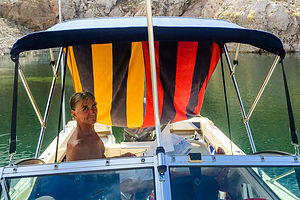 Herb hanging out in Indian Canyon CoveWhen we walked into the Boat House Restaurant, I immediately recognized our waitress as being the politically impassioned one from the night before. I didn’t want to embarrass her so I pretended it never happened. However, when Herb made a comment about having never been here before, meaning Lake Mead Marina, she pointed at me and said, “She has!” which made me feel a bit as if I had been an intruder on her private moment of rage.
Herb hanging out in Indian Canyon CoveWhen we walked into the Boat House Restaurant, I immediately recognized our waitress as being the politically impassioned one from the night before. I didn’t want to embarrass her so I pretended it never happened. However, when Herb made a comment about having never been here before, meaning Lake Mead Marina, she pointed at me and said, “She has!” which made me feel a bit as if I had been an intruder on her private moment of rage.
We quickly changed the subject and asked her if she could recommend some nice, remote coves to anchor in. She called over another gentleman that worked at the marina to join the conversation. Either none of the employees ever get out on the lake, or they’re keeping their favorite coves secret, because neither of them had any suggestions to offer.
After breakfast we went into the marine store to book another night at the dock and ask them about good places to go on the lake - still, nothing. They suggested we buy a detailed map of the coves, which of course they didn’t have, but suggested their nearby sister marina, Las Vegas Boat Harbor, might. I have never seen a marina so unable – or perhaps unwilling – to provide information to its guests.
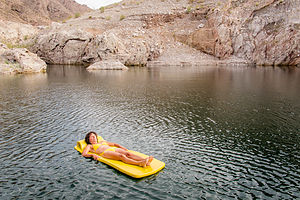 Lolo demonstrating use of float in Indian Canyon CoveSince we had to go to the food store in Boulder City anyway to stock up on supplies, we drove over to the other marina to see if they could perhaps be more helpful. I have a feeling that this is the main marina, because not only did they have the necessary maps and employees that were actually well informed and willing to share their knowledge, but there also was a top-notch concrete launch ramp – nothing like the sandy, undeveloped one we had used the night before.
Lolo demonstrating use of float in Indian Canyon CoveSince we had to go to the food store in Boulder City anyway to stock up on supplies, we drove over to the other marina to see if they could perhaps be more helpful. I have a feeling that this is the main marina, because not only did they have the necessary maps and employees that were actually well informed and willing to share their knowledge, but there also was a top-notch concrete launch ramp – nothing like the sandy, undeveloped one we had used the night before.
Armed with navigational maps, local knowledge, and provisions from the food store, we headed out on the boat for a day of relaxation and fun.
The girl at Las Vegas Boat Harbor had given us the name of several coves to explore that would be scenic as well as possible to anchor in. Anchoring is a challenge in many of them, because the bottom tends to be rocky, making it difficult for the anchor to take hold, or, even worse, get stuck on a rock you finally do get hold of.
The water was smooth as glass and we cruised up the Boulder Basin Arm for about 10 miles into Sandy Cove on our left (excuse me, “port”). There were already a few boats anchored there, so we continued on looking for a cove to have to ourselves.
 Desert Bighorn Sheep in Indian Canyon CoveJust across from Sandy Cove, on the south side of the Arm, we discovered lovely and deserted Indian Canyon Cove. As expected, we (and by we, I mean Herb) had to spend a bit of time making sure we wouldn’t drift into the cliff walls. Not trusting solely that an anchor dropped to the bottom would keep us secure, Herb swam to the canyon walls – there really was no shoreline – to hook an anchor behind a rock.
Desert Bighorn Sheep in Indian Canyon CoveJust across from Sandy Cove, on the south side of the Arm, we discovered lovely and deserted Indian Canyon Cove. As expected, we (and by we, I mean Herb) had to spend a bit of time making sure we wouldn’t drift into the cliff walls. Not trusting solely that an anchor dropped to the bottom would keep us secure, Herb swam to the canyon walls – there really was no shoreline – to hook an anchor behind a rock.
Once secure, we set about the business of reading, swimming, gazing at the canyon walls, etc. It was as if we were the only inhabitants for miles – at least, the only ones on two feet. We were only there a short time before we heard what we thought was a minor rockslide along the canyon. For the next half hour, we quietly watched five desert bighorn sheep delicately make their way down the steep canyon wall to drink from the lake. They were absolutely beautiful!
It was quite hot out – probably close to 90 degrees -- but frequent dips in the 80 degree water made it very comfortable. We even managed to use our yellow float, which over the 10 years we have owned it, has never failed to wash away all our stress and cares.
 Lolo admiring the sunsetOn our way back, we stopped briefly in Fishfinder Cove to watch another incredible sunset.
Lolo admiring the sunsetOn our way back, we stopped briefly in Fishfinder Cove to watch another incredible sunset.
Afterwards, my trusty captain safely navigated us in the dark back to the marina. That evening, after showering in the marina showers, we sipped wine, watched the stars, and ate the delicious salads we had bought at the Boulder City Vons today.
It had been a great day! Everyone needs some pristine wilderness to replenish the soul. A good marina shower after that replenishing isn’t so bad either.
Day 3 –the Narrows and Sidewinder Canyon
This was the day I promised Herb that I would enthusiastically leave the comforts and conveniences of the marina to camp out in the wild in a cove of his choice.
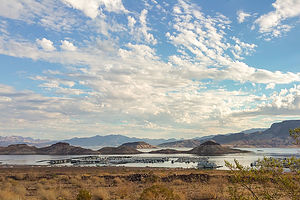 View from our runI tend to be a bit restless when confined to small spaces, so knowing me as well as he does, Herb suggested we go for a run before departing on our journey - to get it out of my system. He calls it “running the spouse.”
View from our runI tend to be a bit restless when confined to small spaces, so knowing me as well as he does, Herb suggested we go for a run before departing on our journey - to get it out of my system. He calls it “running the spouse.”
As the lake is set in a basin, there was nowhere to go but up. So, we ran up the steep road from the marina back towards the Visitor Center atop the hill. Fortunately, we didn’t have to run along Highway 93, as there was a paved trail that paralleled it. It was already getting hot, so we stopped at the Visitor Center for a drink of water and then headed back down. It felt great to stretch the legs, and the views were fabulous along the way. I was now ready to sit still for awhile.
Back on the boat, we set out across Boulder Basin, which thankfully, once again, was as smooth as glass. In about 10 miles we passed the entrance to Indian Cove Canyon, where we had spent a delightful day yesterday, and continued on towards The Narrows, which connected Boulder Basin to Virgin Basin.
 Approaching the NarrowsThe waterway connecting the two basins is about 5 miles long and significantly narrower (hence, the name), with beautiful cliffs, colored in layers of beiges and browns, rising steeply from the water’s edge. I am not sure, but I think the beige-colored rock used to be underwater when the lake was at full capacity, but is exposed now because the lake is down over 100 feet. That is about how far from the lake surface that the color distinctly changes from beige to brown.
Approaching the NarrowsThe waterway connecting the two basins is about 5 miles long and significantly narrower (hence, the name), with beautiful cliffs, colored in layers of beiges and browns, rising steeply from the water’s edge. I am not sure, but I think the beige-colored rock used to be underwater when the lake was at full capacity, but is exposed now because the lake is down over 100 feet. That is about how far from the lake surface that the color distinctly changes from beige to brown.
Along the way, we cruised into a few coves to scout out possible anchoring spots for the night. The cove map we had bought back at the Last Vegas Bay Marina yesterday underlined in red all the coves that were good for houseboat mooring. These were the only ones we would consider.
Our first contender was Sidewinder Cove on the southern side. It definitely had potential – very private and pretty, with a narrow part at the end where we could place an anchor on the canyon walls on either side.
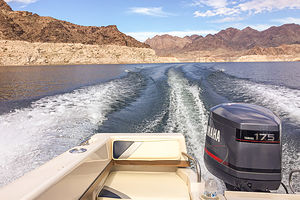 Cruising through the NarrowsWe also checked out James Bay, also on the southern side, and Coyote Cove, on the northern side. Both of us liked Sidewinder Cove best.
Cruising through the NarrowsWe also checked out James Bay, also on the southern side, and Coyote Cove, on the northern side. Both of us liked Sidewinder Cove best.
However, before heading back to settle in for the night, we decided to continue out to the entrance to the Virgin Basin, just to see it. This last mile or so of the connecting waterway between the two basins is the official “Narrows.” At its narrowest point, I would have to guess that the canyon walls on either side are less than 100 yards apart.
Tomorrow we would explore out further into the Virgin Basin and up into the Overton Arm. For now though, we would cruise back to our home for the night at the end of Sidewinder Canyon.
Boating in Paradise is not all fun and glamour, so before settling into relax mode, there was the little issue of anchoring to deal with – and this was an important one, because we would be relying on it to keep us secure while sleeping.
 Sidewinder CoveUsing our yellow float to straddle and paddle to the sides of the canyon, Herb affixed an anchor on each side of the canyon so that we would stay put and not swing around and possibly into the rocks during the night.
Sidewinder CoveUsing our yellow float to straddle and paddle to the sides of the canyon, Herb affixed an anchor on each side of the canyon so that we would stay put and not swing around and possibly into the rocks during the night.
I then took control of the yellow float and showed him how it should be used.
The sun was scheduled to set around 6:30, and since we were positioned between two canyon walls, it would get dark soon after that. Since wine and sunsets go so well together, Captain Herb declared an early start to cocktail hour, especially considering we would probably be in bed by 8:00.
Tonight was a new moon, and Lake Mead is a dark sky area, so needless to say, the number and brightness of the stars we saw that night was incredible.
Day 4 – the Narrows, Overton Arm, and Cathedral Cove
 Captain Herb in Cathedral CoveThe sun rose around 6:30 am, and as a result, so did we. We probably had gotten about 9 hours of sleep anyway. The boat was still securely anchored to the sides of the canyon. In fact, it had stayed so still during the night that I forgot I was even sleeping on the boat.
Captain Herb in Cathedral CoveThe sun rose around 6:30 am, and as a result, so did we. We probably had gotten about 9 hours of sleep anyway. The boat was still securely anchored to the sides of the canyon. In fact, it had stayed so still during the night that I forgot I was even sleeping on the boat.
The canyon that morning was so quiet and serene. I must say I do like the way camping eliminates the clutter and noise of life and makes you focus on the simple things. Breakfast was just that – simple. Just bagels and cream cheese and coffee, and I would have to say they tasted better surrounded by pristine wilderness.
Our plan for the day was to take a cruise back out through the Narrows into the Virgin Basin, and then north up the Overton Arm. During a previous visit to the Lake with the boys back in 2007, we had rented a ski boat from the Echo Bay Marina up in the Overton Arm.
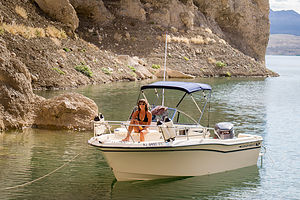 Cathedral CoveHowever, now due to the low lake levels from the multi-year drought, that marina was closed. In fact, it was probably more than a half a mile from the lake now. A sign back at the launch ramp by our marina had warned boaters that there were no services north of The Narrows. That meant that only boats that could carry a lot of gas could make a trip up here and back. The good news was that there was no one up here, which meant that we had this whole section of the lake to ourselves. The bad news was there was no one up here, so we better not get in trouble.
Cathedral CoveHowever, now due to the low lake levels from the multi-year drought, that marina was closed. In fact, it was probably more than a half a mile from the lake now. A sign back at the launch ramp by our marina had warned boaters that there were no services north of The Narrows. That meant that only boats that could carry a lot of gas could make a trip up here and back. The good news was that there was no one up here, which meant that we had this whole section of the lake to ourselves. The bad news was there was no one up here, so we better not get in trouble.
Before departing, we took a quick dip, as it was already getting hot. Also, Herb had to retrieve the anchors from both side of the canyon first, or we weren’t going anywhere.
Back in the boat again, we cruised out of the cove and turned right into the Narrows, which in my opinion is the most stunning part of the lake. In comparison to the closeness of its canyon walls, the openness and vastness of the Virgin Basin felt more like an ocean.
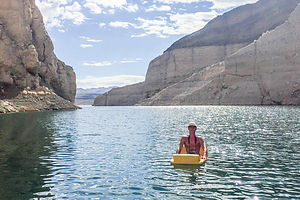 Herb relaxing in Cathedral CoveWe cruised up the Overton Arm looking for coves underlined in red on our map, meaning that they were good for houseboat mooring. Anchoring even in these recommended coves is tough, so we weren’t about to try one that wasn’t.
Herb relaxing in Cathedral CoveWe cruised up the Overton Arm looking for coves underlined in red on our map, meaning that they were good for houseboat mooring. Anchoring even in these recommended coves is tough, so we weren’t about to try one that wasn’t.
After 10 miles of nothing but non-underlined coves, we finally pulled into Cathedral Cove and immediately knew we had found our spot for the day. It was unbelievable, and there even was a little piece of sandy shore at its end where we could disembark and hike into a slot canyon.
If this cove was recommended for houseboat mooring, I would hate to see what one that wasn’t looked like. As we slowly inched our way towards the canyon’s end, I sat at the bow scanning the water for rocks, of which there were many, just enough below the surface to make them difficult to see, but close enough to do damage to a motor.
Anchor setting here was really challenging, because we had to not only ensure that the boat didn’t swing into the sides of the canyon or drift to shore, but also that it didn’t swing into any of the submerged boulders. It took quite a bit of maneuvering before we felt comfortable enough to relax.
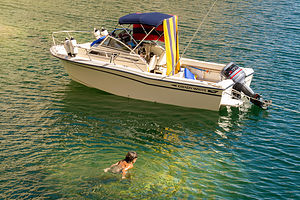 Refreshing dip in Cathedral CoveWe spent an absolutely incredible afternoon swimming, floating on our yellow float, and hiking into the slot canyon. It was like we were the only people on earth. I can see why boaters are hesitant to share information about their favorite coves. I might regret sharing the name of this one myself.
Refreshing dip in Cathedral CoveWe spent an absolutely incredible afternoon swimming, floating on our yellow float, and hiking into the slot canyon. It was like we were the only people on earth. I can see why boaters are hesitant to share information about their favorite coves. I might regret sharing the name of this one myself.
The wind began to pick up later in the afternoon, so we figured we better get out of here while we still could.
Releasing the anchors was going to be difficult. We would have to keep the motor running during the process, because we had to keep the boat from moving into the rocks once it was free. That meant that I, rather than Herb, would have to do the swimming and retrieval of the anchors, because he would need to be driving the boat.
It did take a bit of time, but I was able to free the anchors and get back onto the boat without calamity. Whew!
 Slot Canyon by Cathedral CoveJust as we eased out of the cove into the Overton Arm, the high temperature alarm went off on the boat. Herb turned the engine off and restarted it, but the alarm went off again.
Slot Canyon by Cathedral CoveJust as we eased out of the cove into the Overton Arm, the high temperature alarm went off on the boat. Herb turned the engine off and restarted it, but the alarm went off again.
I quickly switched into panic mode. We were 40 miles from anywhere. All that solitude that we had been gloating about all day was now going to come back to bite us on the bottom.
Meanwhile, Herb calmly surveyed the situation. He took the motor cover off to let it cool off for a bit and checked to see that nothing was blocking the water intake. The best theory he had was that all that sitting in the hot desert sun plus having to idle it for a long time while I struggled with the anchor – figured it was my fault – had caused the engine to overheat. If we just let it sit for awhile and cool down a bit, everything would be fine. God, I certainly hoped so.
After about 20 minutes, he tried the engine again. I braced myself for the screechy alarm, but the only sound was the roar of our trusty motor.
The 36 mile cruise back to the Lake Mead Marina was wonderful – and thankfully, smooth. We even made a quick side trip to see the Hoover Dam.
Day 5 – Prep and Store the Boat
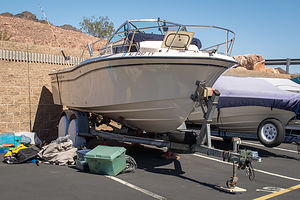 Tucking the boat away for awhileBoating and camping on Lake Mead had been a blast, but it was time to tuck it away and head home.
Tucking the boat away for awhileBoating and camping on Lake Mead had been a blast, but it was time to tuck it away and head home.
Before leaving on this trip, Herb had reserved a 27-foot outdoor spot in the Boulder City Boat Storage facility, about 10 minutes from the lake. We love our boat, so we felt bad about leaving it behind and a little worried that it would be well-cared for – kind of the way we felt when leaving the kids with a babysitter for the first time.
However, we couldn’t have been more pleased with the facility. It was so clean and organized, and the manager was great. We knew the boat would be in good hands.
We had always stored the boat in our back yard (and for the past year in Herb’s brother’s yard), so I had not been as involved in the prepping for storage process. I usually helped Herb back it in the driveway and then went in the house. Apparently, a lot more happened after that, and today I was privy to it. I was exhausted just watching him – just kidding, I helped whenever I could.
Over about a 4 hour period, we (mostly Herb) washed and cleaned the boat, raised it up on jack stands, preserved the gas, removed the batteries, built a frame for a cover and installed the cover and another plastic tarp on top of that, opened the storage lockers for ventilation, emptied its contents into the Suburban, and on and on.
We didn’t get done until 4 o’clock in the afternoon, so any hopes of getting home tonight were pretty dashed. That’s okay. Another night on the road would give us time to reflect on the highs (of which there were many) and lows (of which there were a bit more than we would have liked) of our odyssey, before getting back to the realities of home.
Description
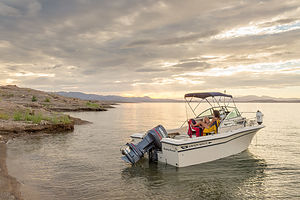 Sunset in Boulder BasinLake Mead National Recreation Area on the Nevada/Arizona border encompasses 1.5 million acres surrounding the Colorado River as it flows from the Grand Canyon through the desert to Lake Mojave. The centerpiece of the recreation area is 110-mile-long Lake Mead, the largest man-made lake in the country and a mecca for swimmers, boaters, anglers, windsurfers, and sightseers.
Sunset in Boulder BasinLake Mead National Recreation Area on the Nevada/Arizona border encompasses 1.5 million acres surrounding the Colorado River as it flows from the Grand Canyon through the desert to Lake Mojave. The centerpiece of the recreation area is 110-mile-long Lake Mead, the largest man-made lake in the country and a mecca for swimmers, boaters, anglers, windsurfers, and sightseers.
The lake was formed back in the 1930s by the construction of the Hoover Dam, which rises 726 feet above the bedrock and stretches 1,244 feet across the Black Canyon, making it the highest concrete dam in the Western Hemisphere. Because of the dam, Lake Mead can store up to 2 years of Colorado River flow. The water is then released in a regulated flow as needed. Today the reservoir irrigates over 2 million acres of land and supplies water for more than 14 million people.
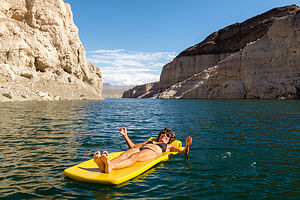 Lolo demonstrating use of floatIn addition to its practical usage, Lake Mead attracts more than 9 million visitors each year who come to enjoy its many recreational opportunities. One of the big draws is the weather, which is usually sunny and hot, up to 110 °F in summer with water temperatures in the mid 80's.
Lolo demonstrating use of floatIn addition to its practical usage, Lake Mead attracts more than 9 million visitors each year who come to enjoy its many recreational opportunities. One of the big draws is the weather, which is usually sunny and hot, up to 110 °F in summer with water temperatures in the mid 80's.
For those that are just driving through, the Lakeshore Scenic Drive along the western end of the lake and the Northshore Scenic Drive along the entire northern portion of the lake wind through desert basins and canyons, providing striking panoramic views of the crystal blue lake set against a background of colorful mountains.
There are 5 major access points to the lake along the way (clockwise from the Hoover Dam):
- Boulder Beach, on the Lakeshore Scenic Drive just a few miles north of the Alan Bible Visitor Center, is the most popular swimming beach on the lake. It is also the only one that you don’t need a boat to get to. Nearby is the Lake Mead Marina, which rents boats, and the shady 154-site Boulder Beach Campground.
- Las Vegas Bay lies seven miles north of Boulder Beach. The 89-site Las Vegas Bay Campground sits on a bluff overlooking the lake. There is also a marina with boat rentals.
- Callville Bay is located at the end of a 4-mile hilly spur road off the Northshore Scenic Drive. There is an 80-site campground and a marina for boat rentals.
- Echo Bay is located at the end of a 5-mile hilly spur road off the Northshore Scenic Drive, about 24 miles east of the turnoff for Callville Bay. The Echo Bay Campground has 166 sites and there is a marina with boat rentals.
- Overton Beach is another 10 miles east on the Northshore Scenic Drive. Its marina and campground have been closed due to lowering lake levels.
- The best way by far to explore the beauty of the lake and the surrounding canyons is by boat. Either rent one on your own at one of the many marinas or take a cruise on a paddlewheeler to and from the Hoover Dam with Lake Mead Cruises.
